Corporate Social Responsibility and Sustainability
VerifiedAdded on 2023/06/09
|21
|5236
|476
AI Summary
This literature review discusses the role, benefits, and key principles of sustainability practices and corporate social responsibility (CSR). It includes a case study of Nokia and how the company carries out sustainability practices and CSR within the organization. The paper also provides suggestions to improve and encourage sustainability practices and CSR. The three levels of sustainability, economic, ecological, and social, are discussed along with the five principles of sustainability. The paper concludes that CSR and sustainability are significant tools for companies to provide wealth and value to stakeholders.
Contribute Materials
Your contribution can guide someone’s learning journey. Share your
documents today.
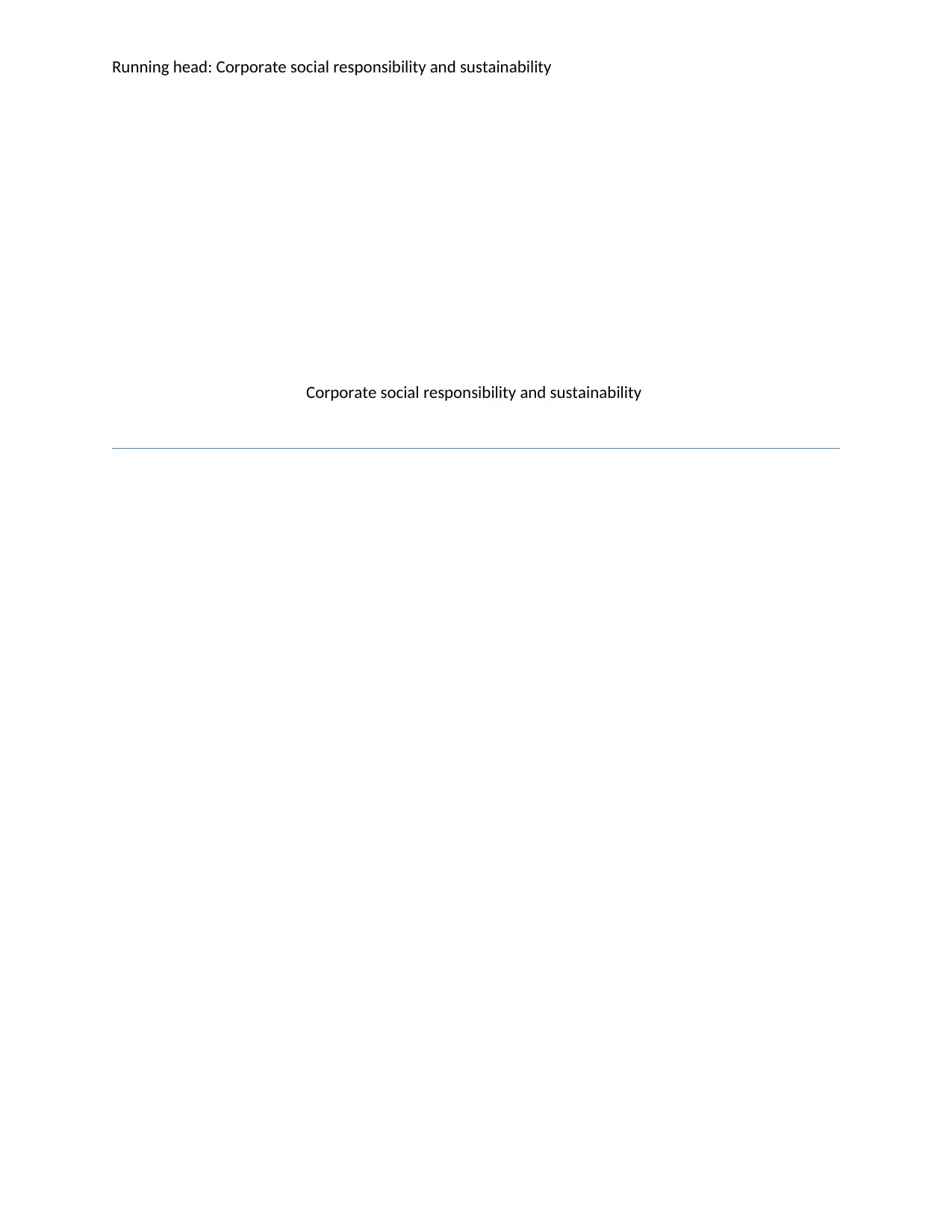
Running head: Corporate social responsibility and sustainability
Corporate social responsibility and sustainability
Corporate social responsibility and sustainability
Secure Best Marks with AI Grader
Need help grading? Try our AI Grader for instant feedback on your assignments.
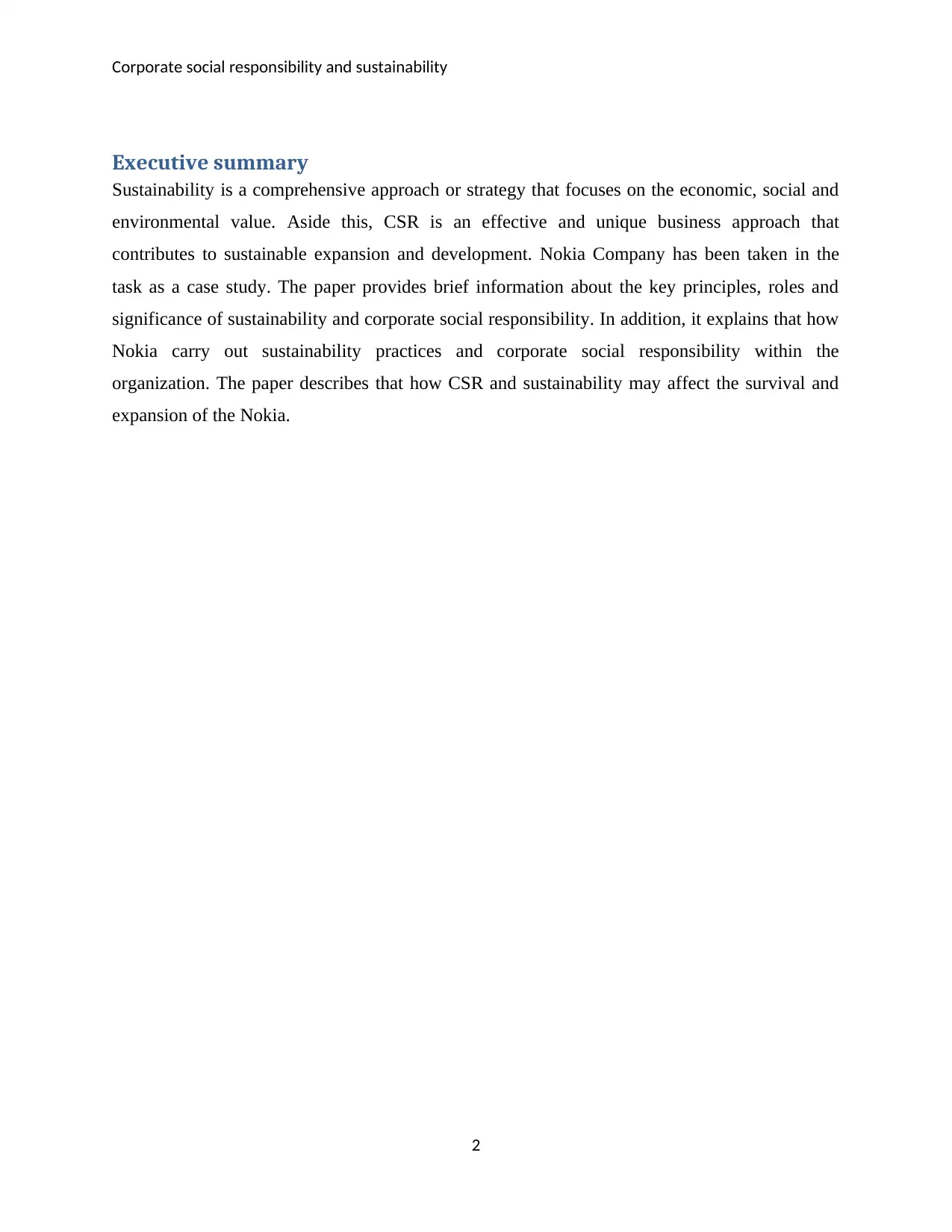
Corporate social responsibility and sustainability
Executive summary
Sustainability is a comprehensive approach or strategy that focuses on the economic, social and
environmental value. Aside this, CSR is an effective and unique business approach that
contributes to sustainable expansion and development. Nokia Company has been taken in the
task as a case study. The paper provides brief information about the key principles, roles and
significance of sustainability and corporate social responsibility. In addition, it explains that how
Nokia carry out sustainability practices and corporate social responsibility within the
organization. The paper describes that how CSR and sustainability may affect the survival and
expansion of the Nokia.
2
Executive summary
Sustainability is a comprehensive approach or strategy that focuses on the economic, social and
environmental value. Aside this, CSR is an effective and unique business approach that
contributes to sustainable expansion and development. Nokia Company has been taken in the
task as a case study. The paper provides brief information about the key principles, roles and
significance of sustainability and corporate social responsibility. In addition, it explains that how
Nokia carry out sustainability practices and corporate social responsibility within the
organization. The paper describes that how CSR and sustainability may affect the survival and
expansion of the Nokia.
2
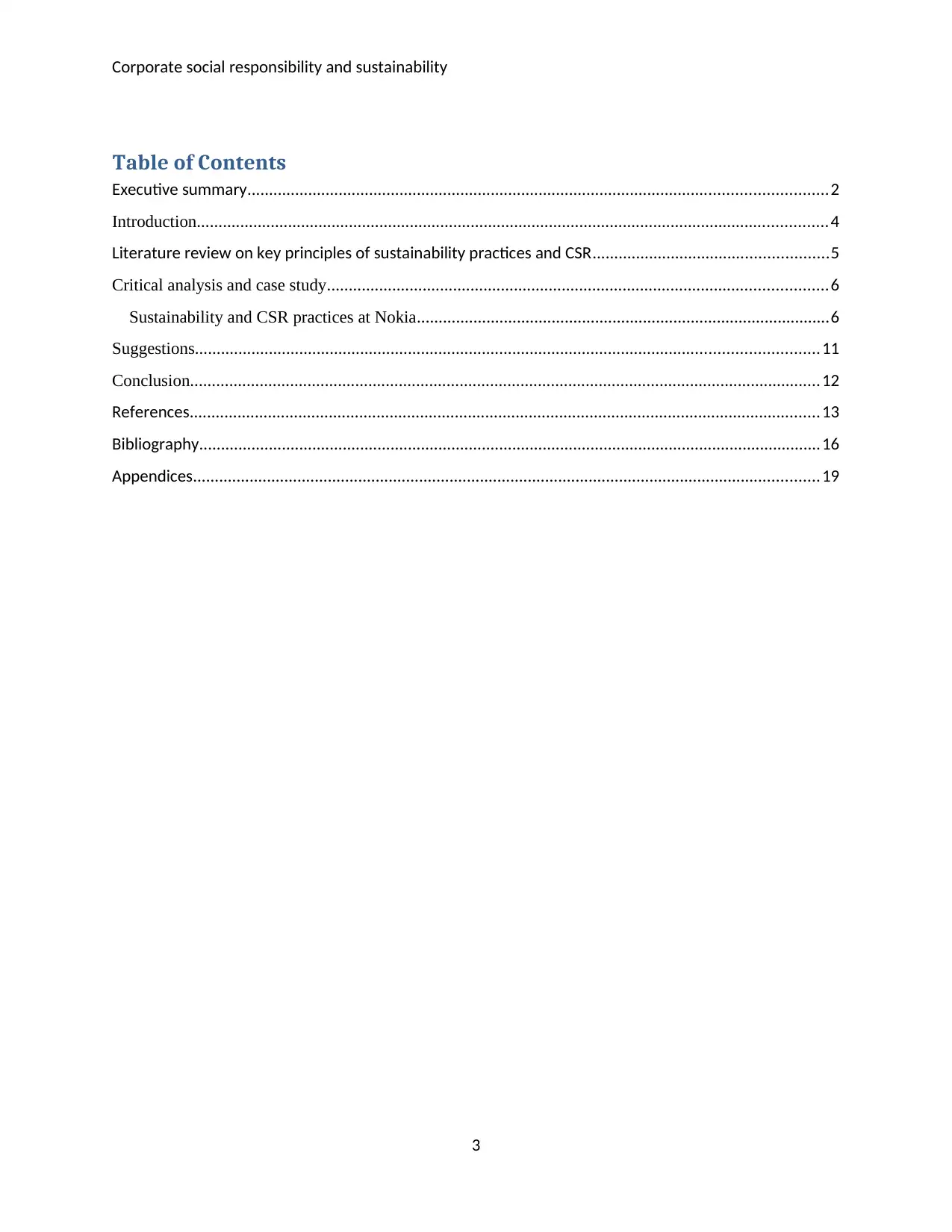
Corporate social responsibility and sustainability
Table of Contents
Executive summary.....................................................................................................................................2
Introduction.................................................................................................................................................4
Literature review on key principles of sustainability practices and CSR......................................................5
Critical analysis and case study...................................................................................................................6
Sustainability and CSR practices at Nokia...............................................................................................6
Suggestions...............................................................................................................................................11
Conclusion.................................................................................................................................................12
References.................................................................................................................................................13
Bibliography...............................................................................................................................................16
Appendices................................................................................................................................................19
3
Table of Contents
Executive summary.....................................................................................................................................2
Introduction.................................................................................................................................................4
Literature review on key principles of sustainability practices and CSR......................................................5
Critical analysis and case study...................................................................................................................6
Sustainability and CSR practices at Nokia...............................................................................................6
Suggestions...............................................................................................................................................11
Conclusion.................................................................................................................................................12
References.................................................................................................................................................13
Bibliography...............................................................................................................................................16
Appendices................................................................................................................................................19
3
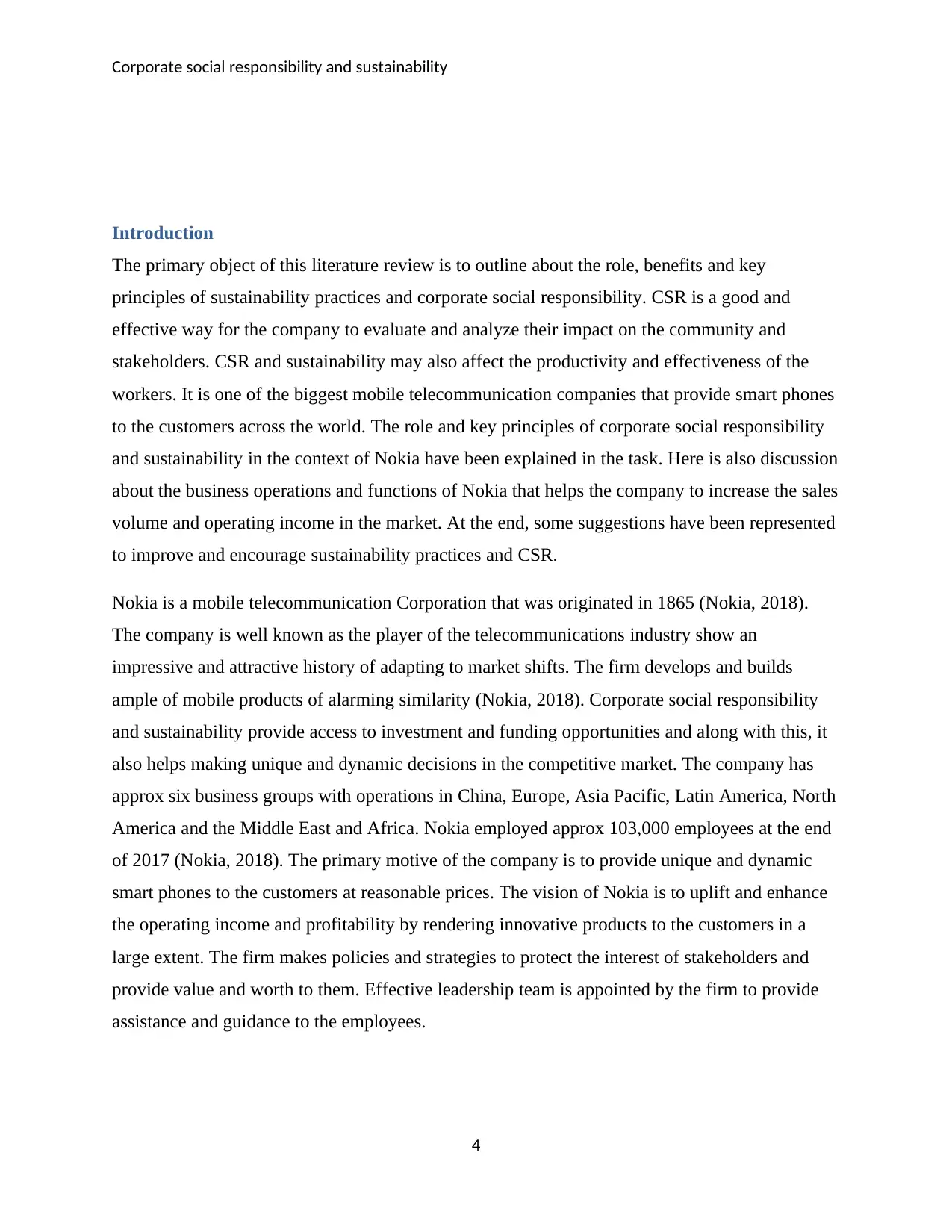
Corporate social responsibility and sustainability
Introduction
The primary object of this literature review is to outline about the role, benefits and key
principles of sustainability practices and corporate social responsibility. CSR is a good and
effective way for the company to evaluate and analyze their impact on the community and
stakeholders. CSR and sustainability may also affect the productivity and effectiveness of the
workers. It is one of the biggest mobile telecommunication companies that provide smart phones
to the customers across the world. The role and key principles of corporate social responsibility
and sustainability in the context of Nokia have been explained in the task. Here is also discussion
about the business operations and functions of Nokia that helps the company to increase the sales
volume and operating income in the market. At the end, some suggestions have been represented
to improve and encourage sustainability practices and CSR.
Nokia is a mobile telecommunication Corporation that was originated in 1865 (Nokia, 2018).
The company is well known as the player of the telecommunications industry show an
impressive and attractive history of adapting to market shifts. The firm develops and builds
ample of mobile products of alarming similarity (Nokia, 2018). Corporate social responsibility
and sustainability provide access to investment and funding opportunities and along with this, it
also helps making unique and dynamic decisions in the competitive market. The company has
approx six business groups with operations in China, Europe, Asia Pacific, Latin America, North
America and the Middle East and Africa. Nokia employed approx 103,000 employees at the end
of 2017 (Nokia, 2018). The primary motive of the company is to provide unique and dynamic
smart phones to the customers at reasonable prices. The vision of Nokia is to uplift and enhance
the operating income and profitability by rendering innovative products to the customers in a
large extent. The firm makes policies and strategies to protect the interest of stakeholders and
provide value and worth to them. Effective leadership team is appointed by the firm to provide
assistance and guidance to the employees.
4
Introduction
The primary object of this literature review is to outline about the role, benefits and key
principles of sustainability practices and corporate social responsibility. CSR is a good and
effective way for the company to evaluate and analyze their impact on the community and
stakeholders. CSR and sustainability may also affect the productivity and effectiveness of the
workers. It is one of the biggest mobile telecommunication companies that provide smart phones
to the customers across the world. The role and key principles of corporate social responsibility
and sustainability in the context of Nokia have been explained in the task. Here is also discussion
about the business operations and functions of Nokia that helps the company to increase the sales
volume and operating income in the market. At the end, some suggestions have been represented
to improve and encourage sustainability practices and CSR.
Nokia is a mobile telecommunication Corporation that was originated in 1865 (Nokia, 2018).
The company is well known as the player of the telecommunications industry show an
impressive and attractive history of adapting to market shifts. The firm develops and builds
ample of mobile products of alarming similarity (Nokia, 2018). Corporate social responsibility
and sustainability provide access to investment and funding opportunities and along with this, it
also helps making unique and dynamic decisions in the competitive market. The company has
approx six business groups with operations in China, Europe, Asia Pacific, Latin America, North
America and the Middle East and Africa. Nokia employed approx 103,000 employees at the end
of 2017 (Nokia, 2018). The primary motive of the company is to provide unique and dynamic
smart phones to the customers at reasonable prices. The vision of Nokia is to uplift and enhance
the operating income and profitability by rendering innovative products to the customers in a
large extent. The firm makes policies and strategies to protect the interest of stakeholders and
provide value and worth to them. Effective leadership team is appointed by the firm to provide
assistance and guidance to the employees.
4
Secure Best Marks with AI Grader
Need help grading? Try our AI Grader for instant feedback on your assignments.
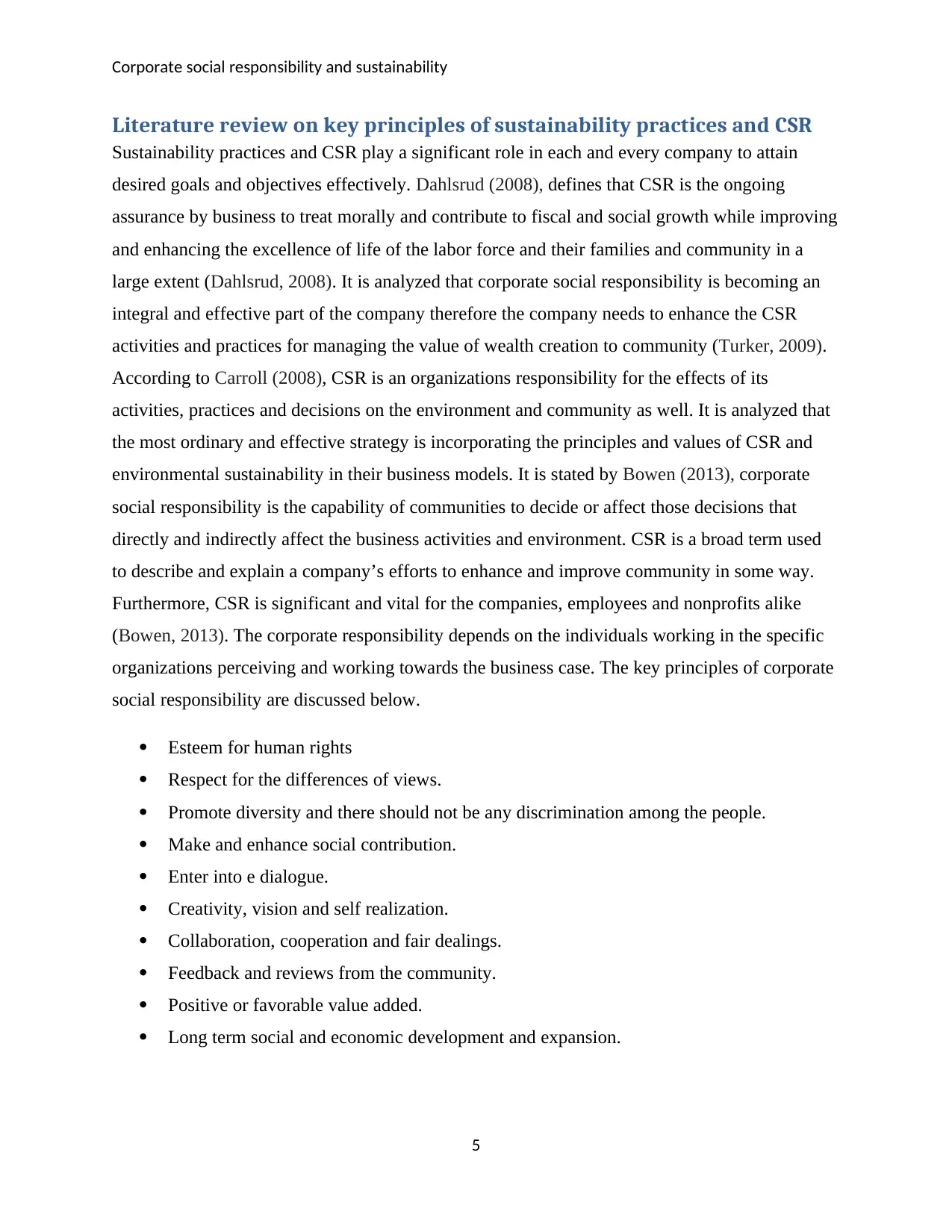
Corporate social responsibility and sustainability
Literature review on key principles of sustainability practices and CSR
Sustainability practices and CSR play a significant role in each and every company to attain
desired goals and objectives effectively. Dahlsrud (2008), defines that CSR is the ongoing
assurance by business to treat morally and contribute to fiscal and social growth while improving
and enhancing the excellence of life of the labor force and their families and community in a
large extent (Dahlsrud, 2008). It is analyzed that corporate social responsibility is becoming an
integral and effective part of the company therefore the company needs to enhance the CSR
activities and practices for managing the value of wealth creation to community (Turker, 2009).
According to Carroll (2008), CSR is an organizations responsibility for the effects of its
activities, practices and decisions on the environment and community as well. It is analyzed that
the most ordinary and effective strategy is incorporating the principles and values of CSR and
environmental sustainability in their business models. It is stated by Bowen (2013), corporate
social responsibility is the capability of communities to decide or affect those decisions that
directly and indirectly affect the business activities and environment. CSR is a broad term used
to describe and explain a company’s efforts to enhance and improve community in some way.
Furthermore, CSR is significant and vital for the companies, employees and nonprofits alike
(Bowen, 2013). The corporate responsibility depends on the individuals working in the specific
organizations perceiving and working towards the business case. The key principles of corporate
social responsibility are discussed below.
Esteem for human rights
Respect for the differences of views.
Promote diversity and there should not be any discrimination among the people.
Make and enhance social contribution.
Enter into e dialogue.
Creativity, vision and self realization.
Collaboration, cooperation and fair dealings.
Feedback and reviews from the community.
Positive or favorable value added.
Long term social and economic development and expansion.
5
Literature review on key principles of sustainability practices and CSR
Sustainability practices and CSR play a significant role in each and every company to attain
desired goals and objectives effectively. Dahlsrud (2008), defines that CSR is the ongoing
assurance by business to treat morally and contribute to fiscal and social growth while improving
and enhancing the excellence of life of the labor force and their families and community in a
large extent (Dahlsrud, 2008). It is analyzed that corporate social responsibility is becoming an
integral and effective part of the company therefore the company needs to enhance the CSR
activities and practices for managing the value of wealth creation to community (Turker, 2009).
According to Carroll (2008), CSR is an organizations responsibility for the effects of its
activities, practices and decisions on the environment and community as well. It is analyzed that
the most ordinary and effective strategy is incorporating the principles and values of CSR and
environmental sustainability in their business models. It is stated by Bowen (2013), corporate
social responsibility is the capability of communities to decide or affect those decisions that
directly and indirectly affect the business activities and environment. CSR is a broad term used
to describe and explain a company’s efforts to enhance and improve community in some way.
Furthermore, CSR is significant and vital for the companies, employees and nonprofits alike
(Bowen, 2013). The corporate responsibility depends on the individuals working in the specific
organizations perceiving and working towards the business case. The key principles of corporate
social responsibility are discussed below.
Esteem for human rights
Respect for the differences of views.
Promote diversity and there should not be any discrimination among the people.
Make and enhance social contribution.
Enter into e dialogue.
Creativity, vision and self realization.
Collaboration, cooperation and fair dealings.
Feedback and reviews from the community.
Positive or favorable value added.
Long term social and economic development and expansion.
5
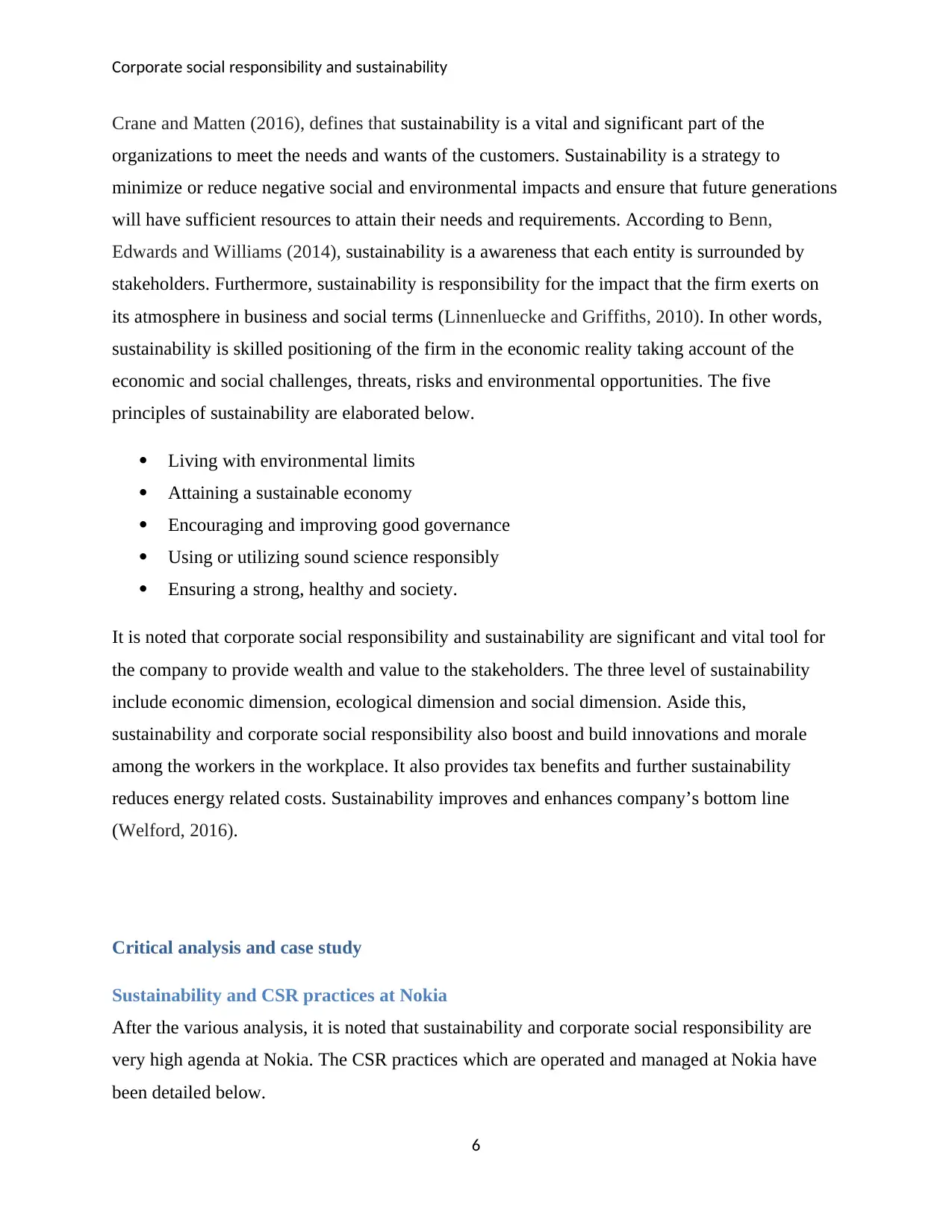
Corporate social responsibility and sustainability
Crane and Matten (2016), defines that sustainability is a vital and significant part of the
organizations to meet the needs and wants of the customers. Sustainability is a strategy to
minimize or reduce negative social and environmental impacts and ensure that future generations
will have sufficient resources to attain their needs and requirements. According to Benn,
Edwards and Williams (2014), sustainability is a awareness that each entity is surrounded by
stakeholders. Furthermore, sustainability is responsibility for the impact that the firm exerts on
its atmosphere in business and social terms (Linnenluecke and Griffiths, 2010). In other words,
sustainability is skilled positioning of the firm in the economic reality taking account of the
economic and social challenges, threats, risks and environmental opportunities. The five
principles of sustainability are elaborated below.
Living with environmental limits
Attaining a sustainable economy
Encouraging and improving good governance
Using or utilizing sound science responsibly
Ensuring a strong, healthy and society.
It is noted that corporate social responsibility and sustainability are significant and vital tool for
the company to provide wealth and value to the stakeholders. The three level of sustainability
include economic dimension, ecological dimension and social dimension. Aside this,
sustainability and corporate social responsibility also boost and build innovations and morale
among the workers in the workplace. It also provides tax benefits and further sustainability
reduces energy related costs. Sustainability improves and enhances company’s bottom line
(Welford, 2016).
Critical analysis and case study
Sustainability and CSR practices at Nokia
After the various analysis, it is noted that sustainability and corporate social responsibility are
very high agenda at Nokia. The CSR practices which are operated and managed at Nokia have
been detailed below.
6
Crane and Matten (2016), defines that sustainability is a vital and significant part of the
organizations to meet the needs and wants of the customers. Sustainability is a strategy to
minimize or reduce negative social and environmental impacts and ensure that future generations
will have sufficient resources to attain their needs and requirements. According to Benn,
Edwards and Williams (2014), sustainability is a awareness that each entity is surrounded by
stakeholders. Furthermore, sustainability is responsibility for the impact that the firm exerts on
its atmosphere in business and social terms (Linnenluecke and Griffiths, 2010). In other words,
sustainability is skilled positioning of the firm in the economic reality taking account of the
economic and social challenges, threats, risks and environmental opportunities. The five
principles of sustainability are elaborated below.
Living with environmental limits
Attaining a sustainable economy
Encouraging and improving good governance
Using or utilizing sound science responsibly
Ensuring a strong, healthy and society.
It is noted that corporate social responsibility and sustainability are significant and vital tool for
the company to provide wealth and value to the stakeholders. The three level of sustainability
include economic dimension, ecological dimension and social dimension. Aside this,
sustainability and corporate social responsibility also boost and build innovations and morale
among the workers in the workplace. It also provides tax benefits and further sustainability
reduces energy related costs. Sustainability improves and enhances company’s bottom line
(Welford, 2016).
Critical analysis and case study
Sustainability and CSR practices at Nokia
After the various analysis, it is noted that sustainability and corporate social responsibility are
very high agenda at Nokia. The CSR practices which are operated and managed at Nokia have
been detailed below.
6
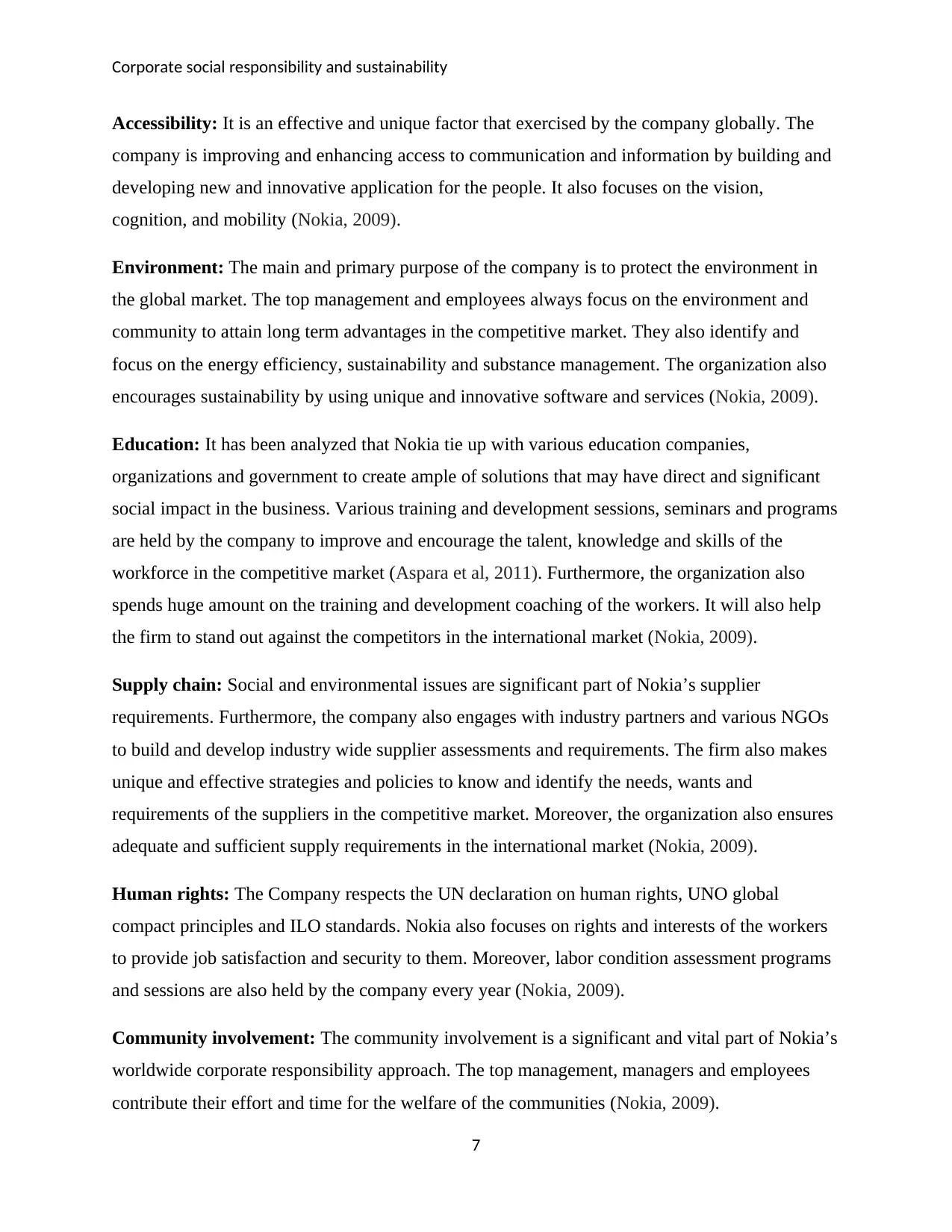
Corporate social responsibility and sustainability
Accessibility: It is an effective and unique factor that exercised by the company globally. The
company is improving and enhancing access to communication and information by building and
developing new and innovative application for the people. It also focuses on the vision,
cognition, and mobility (Nokia, 2009).
Environment: The main and primary purpose of the company is to protect the environment in
the global market. The top management and employees always focus on the environment and
community to attain long term advantages in the competitive market. They also identify and
focus on the energy efficiency, sustainability and substance management. The organization also
encourages sustainability by using unique and innovative software and services (Nokia, 2009).
Education: It has been analyzed that Nokia tie up with various education companies,
organizations and government to create ample of solutions that may have direct and significant
social impact in the business. Various training and development sessions, seminars and programs
are held by the company to improve and encourage the talent, knowledge and skills of the
workforce in the competitive market (Aspara et al, 2011). Furthermore, the organization also
spends huge amount on the training and development coaching of the workers. It will also help
the firm to stand out against the competitors in the international market (Nokia, 2009).
Supply chain: Social and environmental issues are significant part of Nokia’s supplier
requirements. Furthermore, the company also engages with industry partners and various NGOs
to build and develop industry wide supplier assessments and requirements. The firm also makes
unique and effective strategies and policies to know and identify the needs, wants and
requirements of the suppliers in the competitive market. Moreover, the organization also ensures
adequate and sufficient supply requirements in the international market (Nokia, 2009).
Human rights: The Company respects the UN declaration on human rights, UNO global
compact principles and ILO standards. Nokia also focuses on rights and interests of the workers
to provide job satisfaction and security to them. Moreover, labor condition assessment programs
and sessions are also held by the company every year (Nokia, 2009).
Community involvement: The community involvement is a significant and vital part of Nokia’s
worldwide corporate responsibility approach. The top management, managers and employees
contribute their effort and time for the welfare of the communities (Nokia, 2009).
7
Accessibility: It is an effective and unique factor that exercised by the company globally. The
company is improving and enhancing access to communication and information by building and
developing new and innovative application for the people. It also focuses on the vision,
cognition, and mobility (Nokia, 2009).
Environment: The main and primary purpose of the company is to protect the environment in
the global market. The top management and employees always focus on the environment and
community to attain long term advantages in the competitive market. They also identify and
focus on the energy efficiency, sustainability and substance management. The organization also
encourages sustainability by using unique and innovative software and services (Nokia, 2009).
Education: It has been analyzed that Nokia tie up with various education companies,
organizations and government to create ample of solutions that may have direct and significant
social impact in the business. Various training and development sessions, seminars and programs
are held by the company to improve and encourage the talent, knowledge and skills of the
workforce in the competitive market (Aspara et al, 2011). Furthermore, the organization also
spends huge amount on the training and development coaching of the workers. It will also help
the firm to stand out against the competitors in the international market (Nokia, 2009).
Supply chain: Social and environmental issues are significant part of Nokia’s supplier
requirements. Furthermore, the company also engages with industry partners and various NGOs
to build and develop industry wide supplier assessments and requirements. The firm also makes
unique and effective strategies and policies to know and identify the needs, wants and
requirements of the suppliers in the competitive market. Moreover, the organization also ensures
adequate and sufficient supply requirements in the international market (Nokia, 2009).
Human rights: The Company respects the UN declaration on human rights, UNO global
compact principles and ILO standards. Nokia also focuses on rights and interests of the workers
to provide job satisfaction and security to them. Moreover, labor condition assessment programs
and sessions are also held by the company every year (Nokia, 2009).
Community involvement: The community involvement is a significant and vital part of Nokia’s
worldwide corporate responsibility approach. The top management, managers and employees
contribute their effort and time for the welfare of the communities (Nokia, 2009).
7
Paraphrase This Document
Need a fresh take? Get an instant paraphrase of this document with our AI Paraphraser
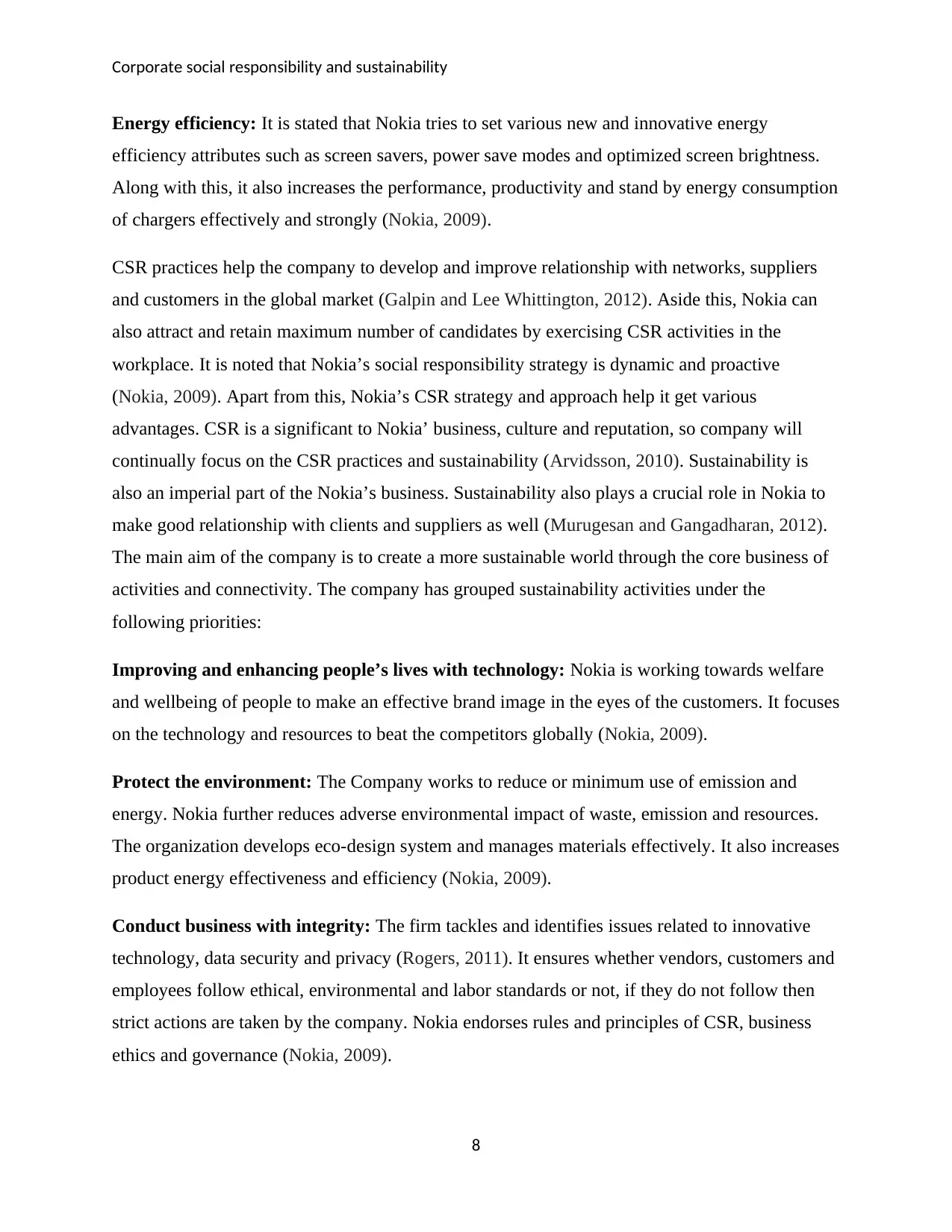
Corporate social responsibility and sustainability
Energy efficiency: It is stated that Nokia tries to set various new and innovative energy
efficiency attributes such as screen savers, power save modes and optimized screen brightness.
Along with this, it also increases the performance, productivity and stand by energy consumption
of chargers effectively and strongly (Nokia, 2009).
CSR practices help the company to develop and improve relationship with networks, suppliers
and customers in the global market (Galpin and Lee Whittington, 2012). Aside this, Nokia can
also attract and retain maximum number of candidates by exercising CSR activities in the
workplace. It is noted that Nokia’s social responsibility strategy is dynamic and proactive
(Nokia, 2009). Apart from this, Nokia’s CSR strategy and approach help it get various
advantages. CSR is a significant to Nokia’ business, culture and reputation, so company will
continually focus on the CSR practices and sustainability (Arvidsson, 2010). Sustainability is
also an imperial part of the Nokia’s business. Sustainability also plays a crucial role in Nokia to
make good relationship with clients and suppliers as well (Murugesan and Gangadharan, 2012).
The main aim of the company is to create a more sustainable world through the core business of
activities and connectivity. The company has grouped sustainability activities under the
following priorities:
Improving and enhancing people’s lives with technology: Nokia is working towards welfare
and wellbeing of people to make an effective brand image in the eyes of the customers. It focuses
on the technology and resources to beat the competitors globally (Nokia, 2009).
Protect the environment: The Company works to reduce or minimum use of emission and
energy. Nokia further reduces adverse environmental impact of waste, emission and resources.
The organization develops eco-design system and manages materials effectively. It also increases
product energy effectiveness and efficiency (Nokia, 2009).
Conduct business with integrity: The firm tackles and identifies issues related to innovative
technology, data security and privacy (Rogers, 2011). It ensures whether vendors, customers and
employees follow ethical, environmental and labor standards or not, if they do not follow then
strict actions are taken by the company. Nokia endorses rules and principles of CSR, business
ethics and governance (Nokia, 2009).
8
Energy efficiency: It is stated that Nokia tries to set various new and innovative energy
efficiency attributes such as screen savers, power save modes and optimized screen brightness.
Along with this, it also increases the performance, productivity and stand by energy consumption
of chargers effectively and strongly (Nokia, 2009).
CSR practices help the company to develop and improve relationship with networks, suppliers
and customers in the global market (Galpin and Lee Whittington, 2012). Aside this, Nokia can
also attract and retain maximum number of candidates by exercising CSR activities in the
workplace. It is noted that Nokia’s social responsibility strategy is dynamic and proactive
(Nokia, 2009). Apart from this, Nokia’s CSR strategy and approach help it get various
advantages. CSR is a significant to Nokia’ business, culture and reputation, so company will
continually focus on the CSR practices and sustainability (Arvidsson, 2010). Sustainability is
also an imperial part of the Nokia’s business. Sustainability also plays a crucial role in Nokia to
make good relationship with clients and suppliers as well (Murugesan and Gangadharan, 2012).
The main aim of the company is to create a more sustainable world through the core business of
activities and connectivity. The company has grouped sustainability activities under the
following priorities:
Improving and enhancing people’s lives with technology: Nokia is working towards welfare
and wellbeing of people to make an effective brand image in the eyes of the customers. It focuses
on the technology and resources to beat the competitors globally (Nokia, 2009).
Protect the environment: The Company works to reduce or minimum use of emission and
energy. Nokia further reduces adverse environmental impact of waste, emission and resources.
The organization develops eco-design system and manages materials effectively. It also increases
product energy effectiveness and efficiency (Nokia, 2009).
Conduct business with integrity: The firm tackles and identifies issues related to innovative
technology, data security and privacy (Rogers, 2011). It ensures whether vendors, customers and
employees follow ethical, environmental and labor standards or not, if they do not follow then
strict actions are taken by the company. Nokia endorses rules and principles of CSR, business
ethics and governance (Nokia, 2009).
8
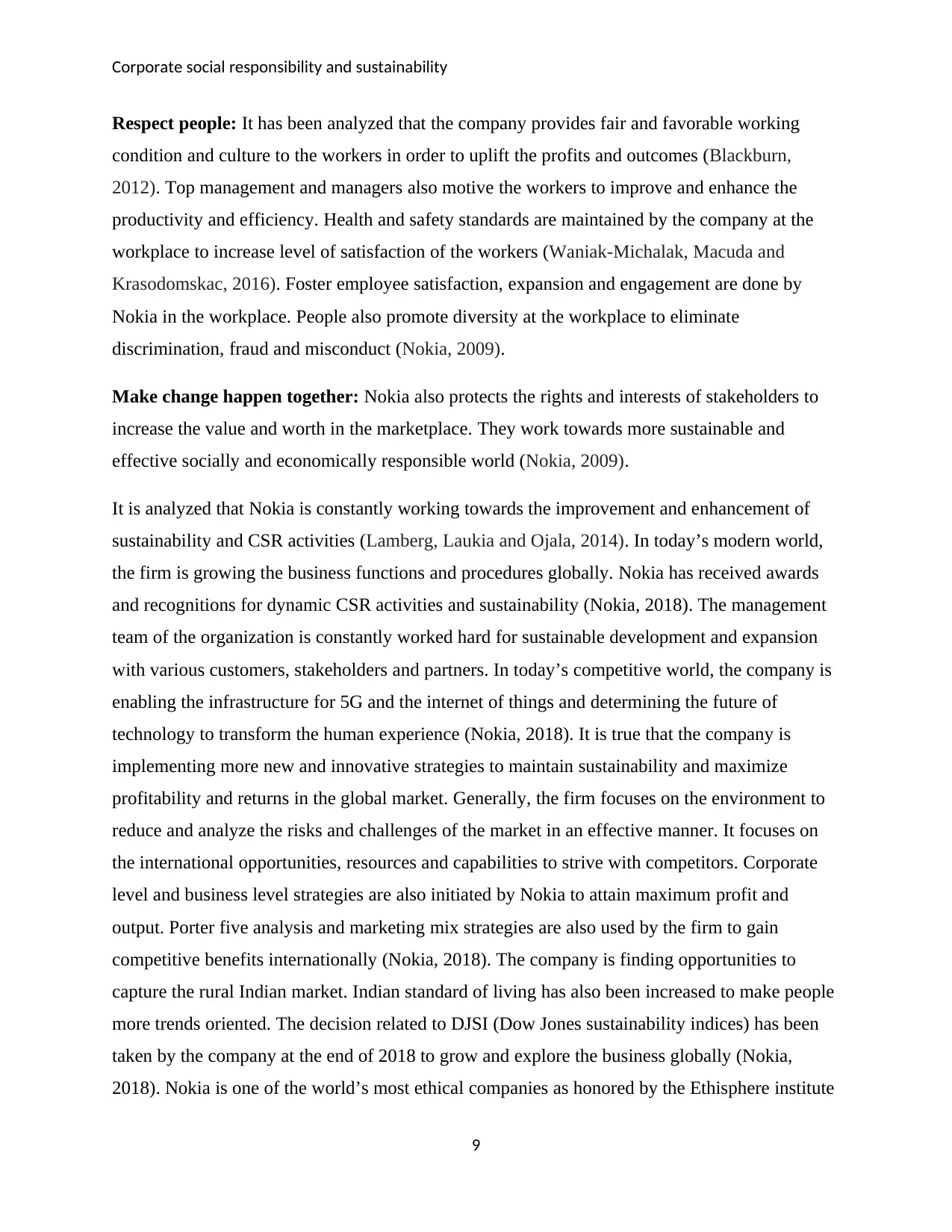
Corporate social responsibility and sustainability
Respect people: It has been analyzed that the company provides fair and favorable working
condition and culture to the workers in order to uplift the profits and outcomes (Blackburn,
2012). Top management and managers also motive the workers to improve and enhance the
productivity and efficiency. Health and safety standards are maintained by the company at the
workplace to increase level of satisfaction of the workers (Waniak-Michalak, Macuda and
Krasodomskac, 2016). Foster employee satisfaction, expansion and engagement are done by
Nokia in the workplace. People also promote diversity at the workplace to eliminate
discrimination, fraud and misconduct (Nokia, 2009).
Make change happen together: Nokia also protects the rights and interests of stakeholders to
increase the value and worth in the marketplace. They work towards more sustainable and
effective socially and economically responsible world (Nokia, 2009).
It is analyzed that Nokia is constantly working towards the improvement and enhancement of
sustainability and CSR activities (Lamberg, Laukia and Ojala, 2014). In today’s modern world,
the firm is growing the business functions and procedures globally. Nokia has received awards
and recognitions for dynamic CSR activities and sustainability (Nokia, 2018). The management
team of the organization is constantly worked hard for sustainable development and expansion
with various customers, stakeholders and partners. In today’s competitive world, the company is
enabling the infrastructure for 5G and the internet of things and determining the future of
technology to transform the human experience (Nokia, 2018). It is true that the company is
implementing more new and innovative strategies to maintain sustainability and maximize
profitability and returns in the global market. Generally, the firm focuses on the environment to
reduce and analyze the risks and challenges of the market in an effective manner. It focuses on
the international opportunities, resources and capabilities to strive with competitors. Corporate
level and business level strategies are also initiated by Nokia to attain maximum profit and
output. Porter five analysis and marketing mix strategies are also used by the firm to gain
competitive benefits internationally (Nokia, 2018). The company is finding opportunities to
capture the rural Indian market. Indian standard of living has also been increased to make people
more trends oriented. The decision related to DJSI (Dow Jones sustainability indices) has been
taken by the company at the end of 2018 to grow and explore the business globally (Nokia,
2018). Nokia is one of the world’s most ethical companies as honored by the Ethisphere institute
9
Respect people: It has been analyzed that the company provides fair and favorable working
condition and culture to the workers in order to uplift the profits and outcomes (Blackburn,
2012). Top management and managers also motive the workers to improve and enhance the
productivity and efficiency. Health and safety standards are maintained by the company at the
workplace to increase level of satisfaction of the workers (Waniak-Michalak, Macuda and
Krasodomskac, 2016). Foster employee satisfaction, expansion and engagement are done by
Nokia in the workplace. People also promote diversity at the workplace to eliminate
discrimination, fraud and misconduct (Nokia, 2009).
Make change happen together: Nokia also protects the rights and interests of stakeholders to
increase the value and worth in the marketplace. They work towards more sustainable and
effective socially and economically responsible world (Nokia, 2009).
It is analyzed that Nokia is constantly working towards the improvement and enhancement of
sustainability and CSR activities (Lamberg, Laukia and Ojala, 2014). In today’s modern world,
the firm is growing the business functions and procedures globally. Nokia has received awards
and recognitions for dynamic CSR activities and sustainability (Nokia, 2018). The management
team of the organization is constantly worked hard for sustainable development and expansion
with various customers, stakeholders and partners. In today’s competitive world, the company is
enabling the infrastructure for 5G and the internet of things and determining the future of
technology to transform the human experience (Nokia, 2018). It is true that the company is
implementing more new and innovative strategies to maintain sustainability and maximize
profitability and returns in the global market. Generally, the firm focuses on the environment to
reduce and analyze the risks and challenges of the market in an effective manner. It focuses on
the international opportunities, resources and capabilities to strive with competitors. Corporate
level and business level strategies are also initiated by Nokia to attain maximum profit and
output. Porter five analysis and marketing mix strategies are also used by the firm to gain
competitive benefits internationally (Nokia, 2018). The company is finding opportunities to
capture the rural Indian market. Indian standard of living has also been increased to make people
more trends oriented. The decision related to DJSI (Dow Jones sustainability indices) has been
taken by the company at the end of 2018 to grow and explore the business globally (Nokia,
2018). Nokia is one of the world’s most ethical companies as honored by the Ethisphere institute
9
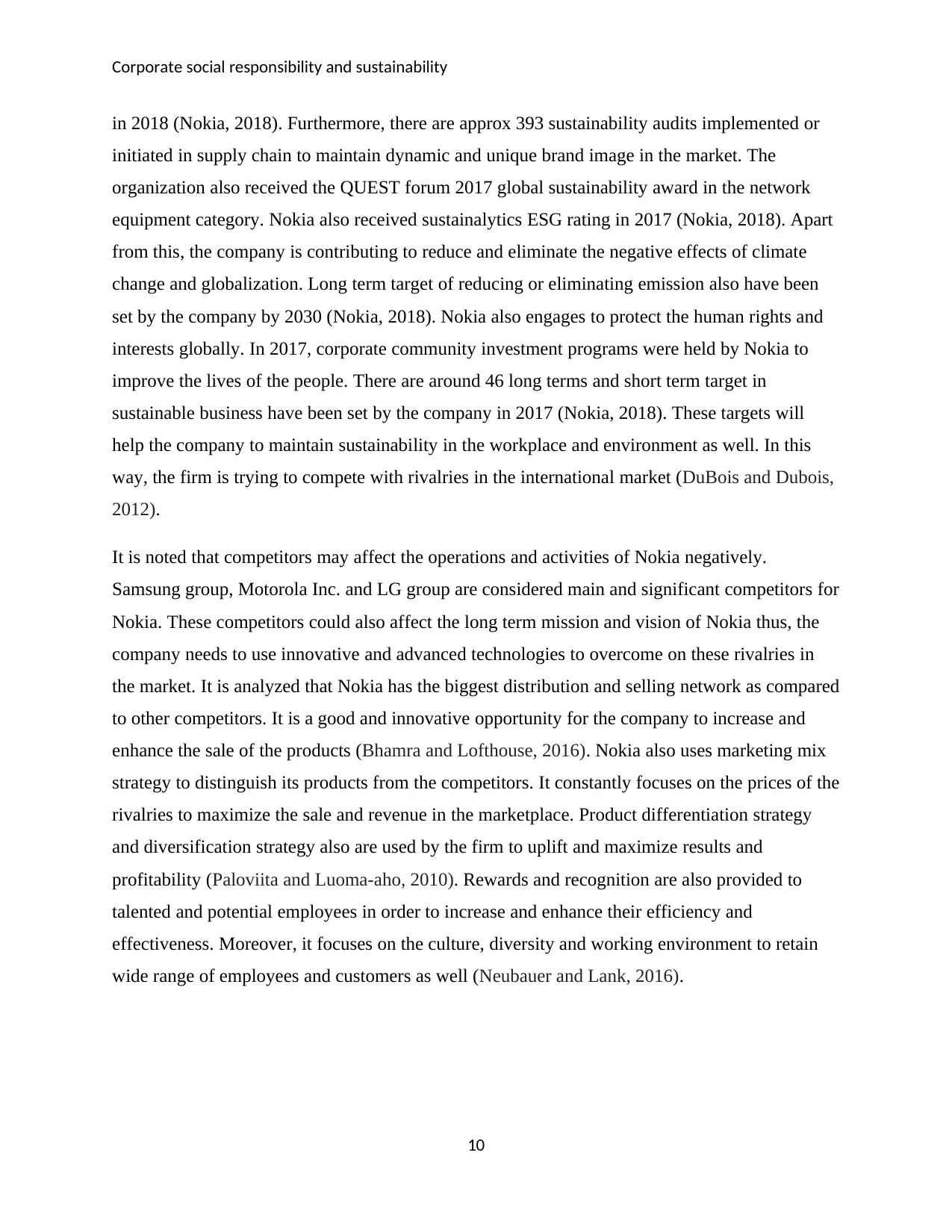
Corporate social responsibility and sustainability
in 2018 (Nokia, 2018). Furthermore, there are approx 393 sustainability audits implemented or
initiated in supply chain to maintain dynamic and unique brand image in the market. The
organization also received the QUEST forum 2017 global sustainability award in the network
equipment category. Nokia also received sustainalytics ESG rating in 2017 (Nokia, 2018). Apart
from this, the company is contributing to reduce and eliminate the negative effects of climate
change and globalization. Long term target of reducing or eliminating emission also have been
set by the company by 2030 (Nokia, 2018). Nokia also engages to protect the human rights and
interests globally. In 2017, corporate community investment programs were held by Nokia to
improve the lives of the people. There are around 46 long terms and short term target in
sustainable business have been set by the company in 2017 (Nokia, 2018). These targets will
help the company to maintain sustainability in the workplace and environment as well. In this
way, the firm is trying to compete with rivalries in the international market (DuBois and Dubois,
2012).
It is noted that competitors may affect the operations and activities of Nokia negatively.
Samsung group, Motorola Inc. and LG group are considered main and significant competitors for
Nokia. These competitors could also affect the long term mission and vision of Nokia thus, the
company needs to use innovative and advanced technologies to overcome on these rivalries in
the market. It is analyzed that Nokia has the biggest distribution and selling network as compared
to other competitors. It is a good and innovative opportunity for the company to increase and
enhance the sale of the products (Bhamra and Lofthouse, 2016). Nokia also uses marketing mix
strategy to distinguish its products from the competitors. It constantly focuses on the prices of the
rivalries to maximize the sale and revenue in the marketplace. Product differentiation strategy
and diversification strategy also are used by the firm to uplift and maximize results and
profitability (Paloviita and Luoma-aho, 2010). Rewards and recognition are also provided to
talented and potential employees in order to increase and enhance their efficiency and
effectiveness. Moreover, it focuses on the culture, diversity and working environment to retain
wide range of employees and customers as well (Neubauer and Lank, 2016).
10
in 2018 (Nokia, 2018). Furthermore, there are approx 393 sustainability audits implemented or
initiated in supply chain to maintain dynamic and unique brand image in the market. The
organization also received the QUEST forum 2017 global sustainability award in the network
equipment category. Nokia also received sustainalytics ESG rating in 2017 (Nokia, 2018). Apart
from this, the company is contributing to reduce and eliminate the negative effects of climate
change and globalization. Long term target of reducing or eliminating emission also have been
set by the company by 2030 (Nokia, 2018). Nokia also engages to protect the human rights and
interests globally. In 2017, corporate community investment programs were held by Nokia to
improve the lives of the people. There are around 46 long terms and short term target in
sustainable business have been set by the company in 2017 (Nokia, 2018). These targets will
help the company to maintain sustainability in the workplace and environment as well. In this
way, the firm is trying to compete with rivalries in the international market (DuBois and Dubois,
2012).
It is noted that competitors may affect the operations and activities of Nokia negatively.
Samsung group, Motorola Inc. and LG group are considered main and significant competitors for
Nokia. These competitors could also affect the long term mission and vision of Nokia thus, the
company needs to use innovative and advanced technologies to overcome on these rivalries in
the market. It is analyzed that Nokia has the biggest distribution and selling network as compared
to other competitors. It is a good and innovative opportunity for the company to increase and
enhance the sale of the products (Bhamra and Lofthouse, 2016). Nokia also uses marketing mix
strategy to distinguish its products from the competitors. It constantly focuses on the prices of the
rivalries to maximize the sale and revenue in the marketplace. Product differentiation strategy
and diversification strategy also are used by the firm to uplift and maximize results and
profitability (Paloviita and Luoma-aho, 2010). Rewards and recognition are also provided to
talented and potential employees in order to increase and enhance their efficiency and
effectiveness. Moreover, it focuses on the culture, diversity and working environment to retain
wide range of employees and customers as well (Neubauer and Lank, 2016).
10
Secure Best Marks with AI Grader
Need help grading? Try our AI Grader for instant feedback on your assignments.
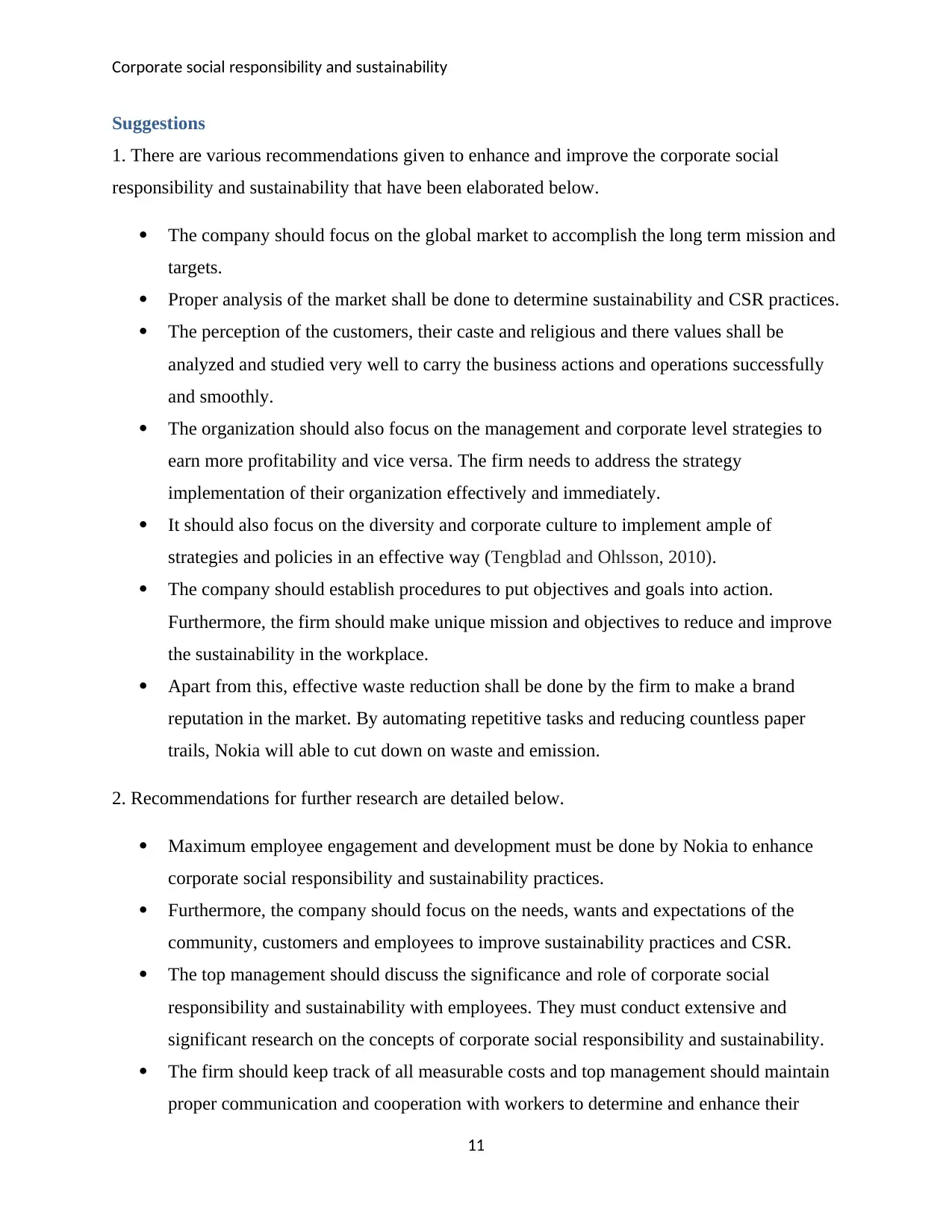
Corporate social responsibility and sustainability
Suggestions
1. There are various recommendations given to enhance and improve the corporate social
responsibility and sustainability that have been elaborated below.
The company should focus on the global market to accomplish the long term mission and
targets.
Proper analysis of the market shall be done to determine sustainability and CSR practices.
The perception of the customers, their caste and religious and there values shall be
analyzed and studied very well to carry the business actions and operations successfully
and smoothly.
The organization should also focus on the management and corporate level strategies to
earn more profitability and vice versa. The firm needs to address the strategy
implementation of their organization effectively and immediately.
It should also focus on the diversity and corporate culture to implement ample of
strategies and policies in an effective way (Tengblad and Ohlsson, 2010).
The company should establish procedures to put objectives and goals into action.
Furthermore, the firm should make unique mission and objectives to reduce and improve
the sustainability in the workplace.
Apart from this, effective waste reduction shall be done by the firm to make a brand
reputation in the market. By automating repetitive tasks and reducing countless paper
trails, Nokia will able to cut down on waste and emission.
2. Recommendations for further research are detailed below.
Maximum employee engagement and development must be done by Nokia to enhance
corporate social responsibility and sustainability practices.
Furthermore, the company should focus on the needs, wants and expectations of the
community, customers and employees to improve sustainability practices and CSR.
The top management should discuss the significance and role of corporate social
responsibility and sustainability with employees. They must conduct extensive and
significant research on the concepts of corporate social responsibility and sustainability.
The firm should keep track of all measurable costs and top management should maintain
proper communication and cooperation with workers to determine and enhance their
11
Suggestions
1. There are various recommendations given to enhance and improve the corporate social
responsibility and sustainability that have been elaborated below.
The company should focus on the global market to accomplish the long term mission and
targets.
Proper analysis of the market shall be done to determine sustainability and CSR practices.
The perception of the customers, their caste and religious and there values shall be
analyzed and studied very well to carry the business actions and operations successfully
and smoothly.
The organization should also focus on the management and corporate level strategies to
earn more profitability and vice versa. The firm needs to address the strategy
implementation of their organization effectively and immediately.
It should also focus on the diversity and corporate culture to implement ample of
strategies and policies in an effective way (Tengblad and Ohlsson, 2010).
The company should establish procedures to put objectives and goals into action.
Furthermore, the firm should make unique mission and objectives to reduce and improve
the sustainability in the workplace.
Apart from this, effective waste reduction shall be done by the firm to make a brand
reputation in the market. By automating repetitive tasks and reducing countless paper
trails, Nokia will able to cut down on waste and emission.
2. Recommendations for further research are detailed below.
Maximum employee engagement and development must be done by Nokia to enhance
corporate social responsibility and sustainability practices.
Furthermore, the company should focus on the needs, wants and expectations of the
community, customers and employees to improve sustainability practices and CSR.
The top management should discuss the significance and role of corporate social
responsibility and sustainability with employees. They must conduct extensive and
significant research on the concepts of corporate social responsibility and sustainability.
The firm should keep track of all measurable costs and top management should maintain
proper communication and cooperation with workers to determine and enhance their
11
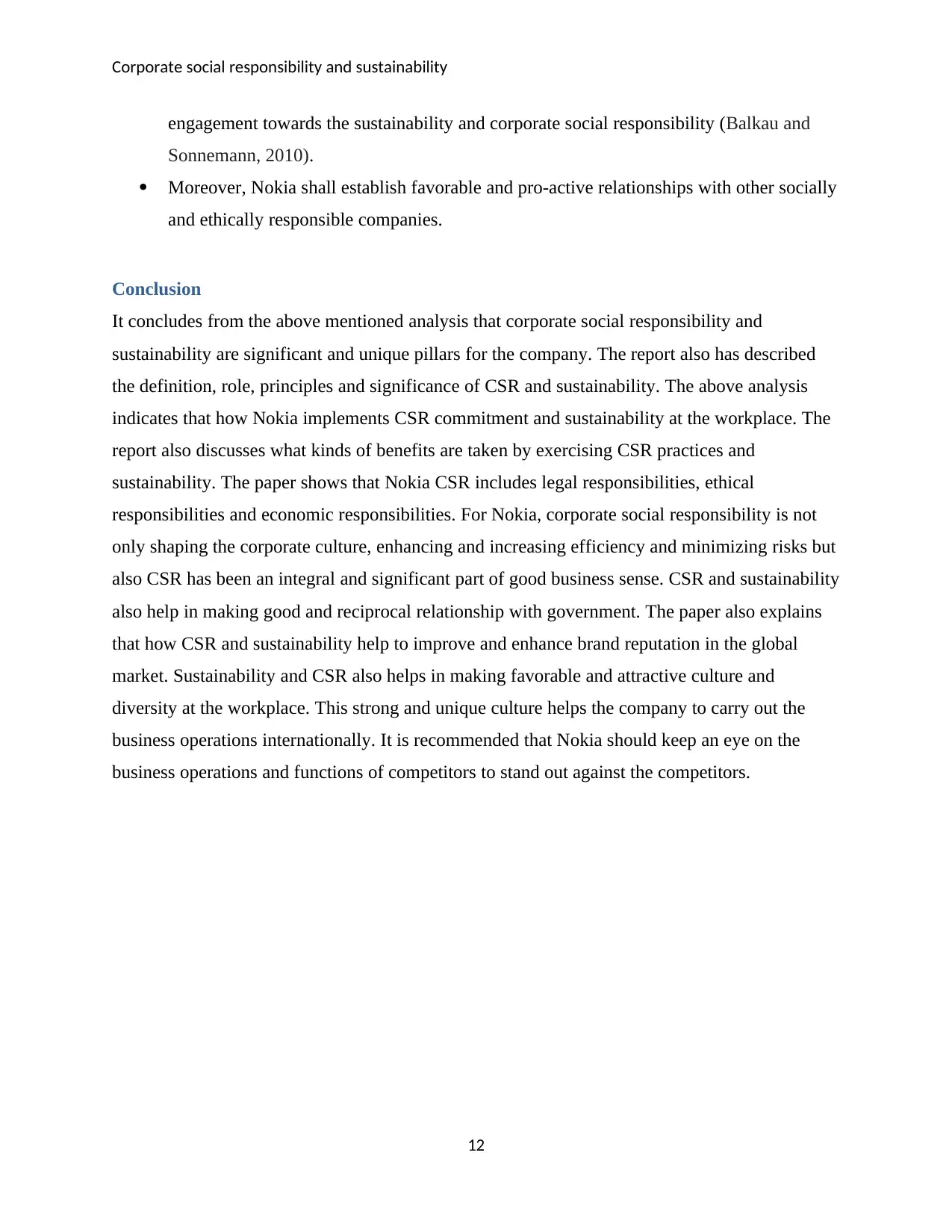
Corporate social responsibility and sustainability
engagement towards the sustainability and corporate social responsibility (Balkau and
Sonnemann, 2010).
Moreover, Nokia shall establish favorable and pro-active relationships with other socially
and ethically responsible companies.
Conclusion
It concludes from the above mentioned analysis that corporate social responsibility and
sustainability are significant and unique pillars for the company. The report also has described
the definition, role, principles and significance of CSR and sustainability. The above analysis
indicates that how Nokia implements CSR commitment and sustainability at the workplace. The
report also discusses what kinds of benefits are taken by exercising CSR practices and
sustainability. The paper shows that Nokia CSR includes legal responsibilities, ethical
responsibilities and economic responsibilities. For Nokia, corporate social responsibility is not
only shaping the corporate culture, enhancing and increasing efficiency and minimizing risks but
also CSR has been an integral and significant part of good business sense. CSR and sustainability
also help in making good and reciprocal relationship with government. The paper also explains
that how CSR and sustainability help to improve and enhance brand reputation in the global
market. Sustainability and CSR also helps in making favorable and attractive culture and
diversity at the workplace. This strong and unique culture helps the company to carry out the
business operations internationally. It is recommended that Nokia should keep an eye on the
business operations and functions of competitors to stand out against the competitors.
12
engagement towards the sustainability and corporate social responsibility (Balkau and
Sonnemann, 2010).
Moreover, Nokia shall establish favorable and pro-active relationships with other socially
and ethically responsible companies.
Conclusion
It concludes from the above mentioned analysis that corporate social responsibility and
sustainability are significant and unique pillars for the company. The report also has described
the definition, role, principles and significance of CSR and sustainability. The above analysis
indicates that how Nokia implements CSR commitment and sustainability at the workplace. The
report also discusses what kinds of benefits are taken by exercising CSR practices and
sustainability. The paper shows that Nokia CSR includes legal responsibilities, ethical
responsibilities and economic responsibilities. For Nokia, corporate social responsibility is not
only shaping the corporate culture, enhancing and increasing efficiency and minimizing risks but
also CSR has been an integral and significant part of good business sense. CSR and sustainability
also help in making good and reciprocal relationship with government. The paper also explains
that how CSR and sustainability help to improve and enhance brand reputation in the global
market. Sustainability and CSR also helps in making favorable and attractive culture and
diversity at the workplace. This strong and unique culture helps the company to carry out the
business operations internationally. It is recommended that Nokia should keep an eye on the
business operations and functions of competitors to stand out against the competitors.
12
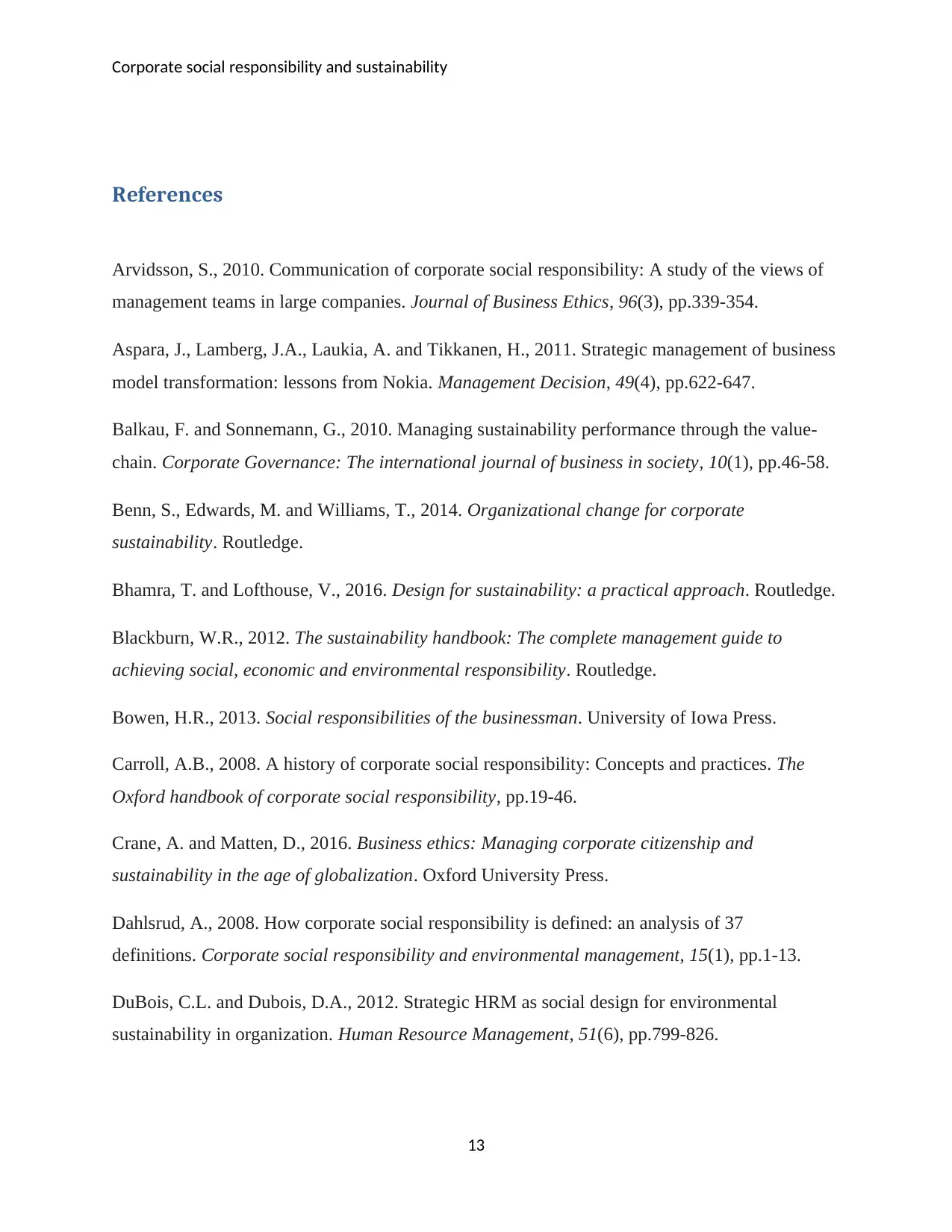
Corporate social responsibility and sustainability
References
Arvidsson, S., 2010. Communication of corporate social responsibility: A study of the views of
management teams in large companies. Journal of Business Ethics, 96(3), pp.339-354.
Aspara, J., Lamberg, J.A., Laukia, A. and Tikkanen, H., 2011. Strategic management of business
model transformation: lessons from Nokia. Management Decision, 49(4), pp.622-647.
Balkau, F. and Sonnemann, G., 2010. Managing sustainability performance through the value-
chain. Corporate Governance: The international journal of business in society, 10(1), pp.46-58.
Benn, S., Edwards, M. and Williams, T., 2014. Organizational change for corporate
sustainability. Routledge.
Bhamra, T. and Lofthouse, V., 2016. Design for sustainability: a practical approach. Routledge.
Blackburn, W.R., 2012. The sustainability handbook: The complete management guide to
achieving social, economic and environmental responsibility. Routledge.
Bowen, H.R., 2013. Social responsibilities of the businessman. University of Iowa Press.
Carroll, A.B., 2008. A history of corporate social responsibility: Concepts and practices. The
Oxford handbook of corporate social responsibility, pp.19-46.
Crane, A. and Matten, D., 2016. Business ethics: Managing corporate citizenship and
sustainability in the age of globalization. Oxford University Press.
Dahlsrud, A., 2008. How corporate social responsibility is defined: an analysis of 37
definitions. Corporate social responsibility and environmental management, 15(1), pp.1-13.
DuBois, C.L. and Dubois, D.A., 2012. Strategic HRM as social design for environmental
sustainability in organization. Human Resource Management, 51(6), pp.799-826.
13
References
Arvidsson, S., 2010. Communication of corporate social responsibility: A study of the views of
management teams in large companies. Journal of Business Ethics, 96(3), pp.339-354.
Aspara, J., Lamberg, J.A., Laukia, A. and Tikkanen, H., 2011. Strategic management of business
model transformation: lessons from Nokia. Management Decision, 49(4), pp.622-647.
Balkau, F. and Sonnemann, G., 2010. Managing sustainability performance through the value-
chain. Corporate Governance: The international journal of business in society, 10(1), pp.46-58.
Benn, S., Edwards, M. and Williams, T., 2014. Organizational change for corporate
sustainability. Routledge.
Bhamra, T. and Lofthouse, V., 2016. Design for sustainability: a practical approach. Routledge.
Blackburn, W.R., 2012. The sustainability handbook: The complete management guide to
achieving social, economic and environmental responsibility. Routledge.
Bowen, H.R., 2013. Social responsibilities of the businessman. University of Iowa Press.
Carroll, A.B., 2008. A history of corporate social responsibility: Concepts and practices. The
Oxford handbook of corporate social responsibility, pp.19-46.
Crane, A. and Matten, D., 2016. Business ethics: Managing corporate citizenship and
sustainability in the age of globalization. Oxford University Press.
Dahlsrud, A., 2008. How corporate social responsibility is defined: an analysis of 37
definitions. Corporate social responsibility and environmental management, 15(1), pp.1-13.
DuBois, C.L. and Dubois, D.A., 2012. Strategic HRM as social design for environmental
sustainability in organization. Human Resource Management, 51(6), pp.799-826.
13
Paraphrase This Document
Need a fresh take? Get an instant paraphrase of this document with our AI Paraphraser
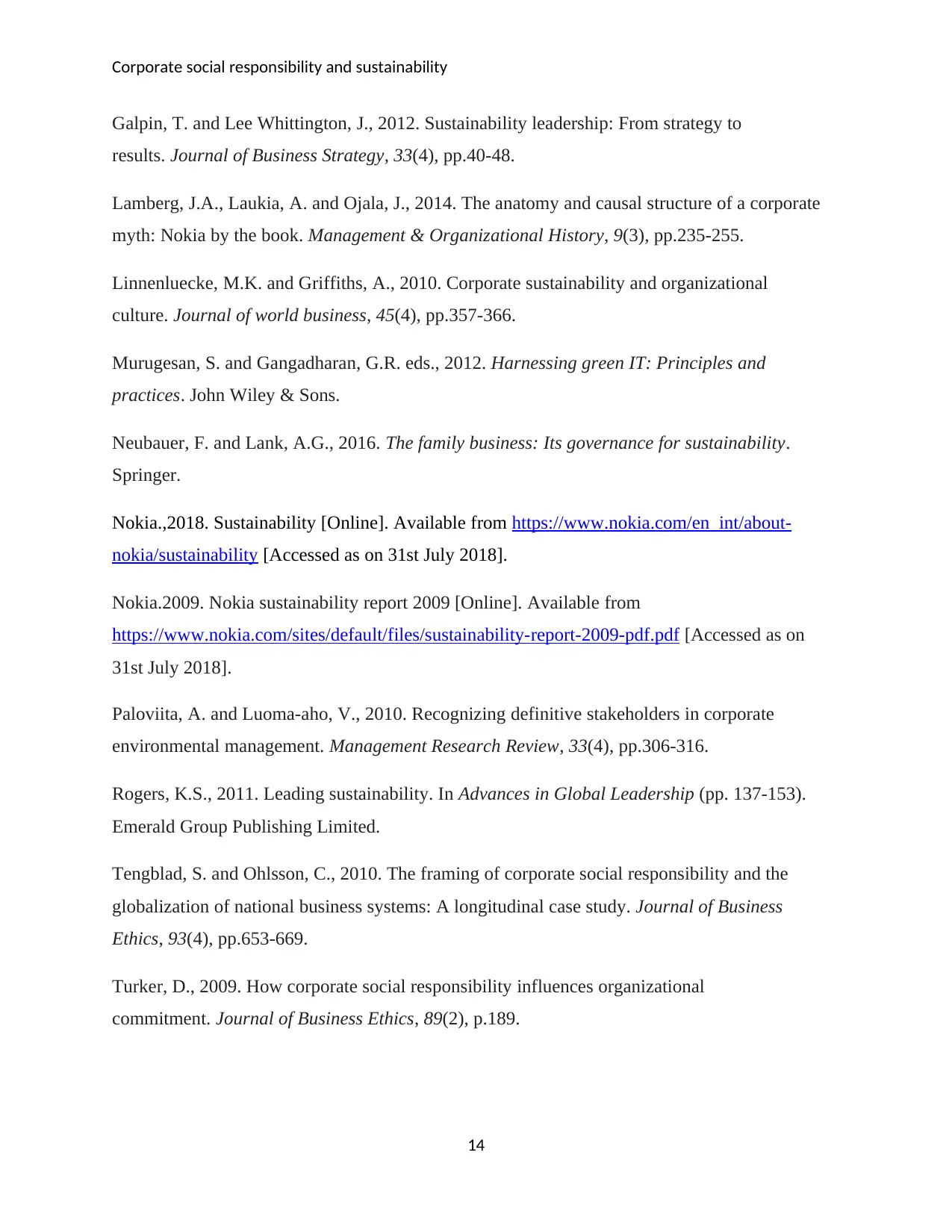
Corporate social responsibility and sustainability
Galpin, T. and Lee Whittington, J., 2012. Sustainability leadership: From strategy to
results. Journal of Business Strategy, 33(4), pp.40-48.
Lamberg, J.A., Laukia, A. and Ojala, J., 2014. The anatomy and causal structure of a corporate
myth: Nokia by the book. Management & Organizational History, 9(3), pp.235-255.
Linnenluecke, M.K. and Griffiths, A., 2010. Corporate sustainability and organizational
culture. Journal of world business, 45(4), pp.357-366.
Murugesan, S. and Gangadharan, G.R. eds., 2012. Harnessing green IT: Principles and
practices. John Wiley & Sons.
Neubauer, F. and Lank, A.G., 2016. The family business: Its governance for sustainability.
Springer.
Nokia.,2018. Sustainability [Online]. Available from https://www.nokia.com/en_int/about-
nokia/sustainability [Accessed as on 31st July 2018].
Nokia.2009. Nokia sustainability report 2009 [Online]. Available from
https://www.nokia.com/sites/default/files/sustainability-report-2009-pdf.pdf [Accessed as on
31st July 2018].
Paloviita, A. and Luoma-aho, V., 2010. Recognizing definitive stakeholders in corporate
environmental management. Management Research Review, 33(4), pp.306-316.
Rogers, K.S., 2011. Leading sustainability. In Advances in Global Leadership (pp. 137-153).
Emerald Group Publishing Limited.
Tengblad, S. and Ohlsson, C., 2010. The framing of corporate social responsibility and the
globalization of national business systems: A longitudinal case study. Journal of Business
Ethics, 93(4), pp.653-669.
Turker, D., 2009. How corporate social responsibility influences organizational
commitment. Journal of Business Ethics, 89(2), p.189.
14
Galpin, T. and Lee Whittington, J., 2012. Sustainability leadership: From strategy to
results. Journal of Business Strategy, 33(4), pp.40-48.
Lamberg, J.A., Laukia, A. and Ojala, J., 2014. The anatomy and causal structure of a corporate
myth: Nokia by the book. Management & Organizational History, 9(3), pp.235-255.
Linnenluecke, M.K. and Griffiths, A., 2010. Corporate sustainability and organizational
culture. Journal of world business, 45(4), pp.357-366.
Murugesan, S. and Gangadharan, G.R. eds., 2012. Harnessing green IT: Principles and
practices. John Wiley & Sons.
Neubauer, F. and Lank, A.G., 2016. The family business: Its governance for sustainability.
Springer.
Nokia.,2018. Sustainability [Online]. Available from https://www.nokia.com/en_int/about-
nokia/sustainability [Accessed as on 31st July 2018].
Nokia.2009. Nokia sustainability report 2009 [Online]. Available from
https://www.nokia.com/sites/default/files/sustainability-report-2009-pdf.pdf [Accessed as on
31st July 2018].
Paloviita, A. and Luoma-aho, V., 2010. Recognizing definitive stakeholders in corporate
environmental management. Management Research Review, 33(4), pp.306-316.
Rogers, K.S., 2011. Leading sustainability. In Advances in Global Leadership (pp. 137-153).
Emerald Group Publishing Limited.
Tengblad, S. and Ohlsson, C., 2010. The framing of corporate social responsibility and the
globalization of national business systems: A longitudinal case study. Journal of Business
Ethics, 93(4), pp.653-669.
Turker, D., 2009. How corporate social responsibility influences organizational
commitment. Journal of Business Ethics, 89(2), p.189.
14
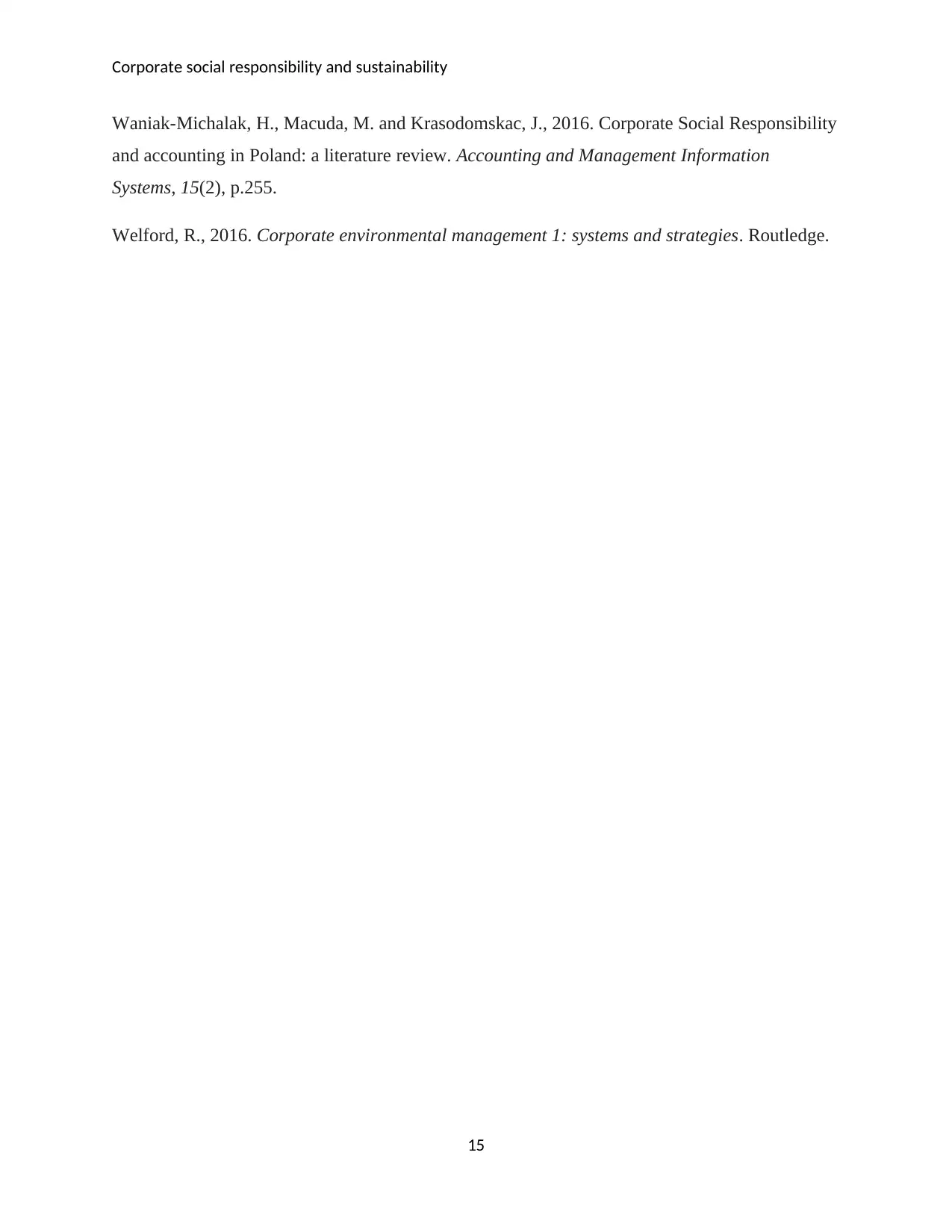
Corporate social responsibility and sustainability
Waniak-Michalak, H., Macuda, M. and Krasodomskac, J., 2016. Corporate Social Responsibility
and accounting in Poland: a literature review. Accounting and Management Information
Systems, 15(2), p.255.
Welford, R., 2016. Corporate environmental management 1: systems and strategies. Routledge.
15
Waniak-Michalak, H., Macuda, M. and Krasodomskac, J., 2016. Corporate Social Responsibility
and accounting in Poland: a literature review. Accounting and Management Information
Systems, 15(2), p.255.
Welford, R., 2016. Corporate environmental management 1: systems and strategies. Routledge.
15
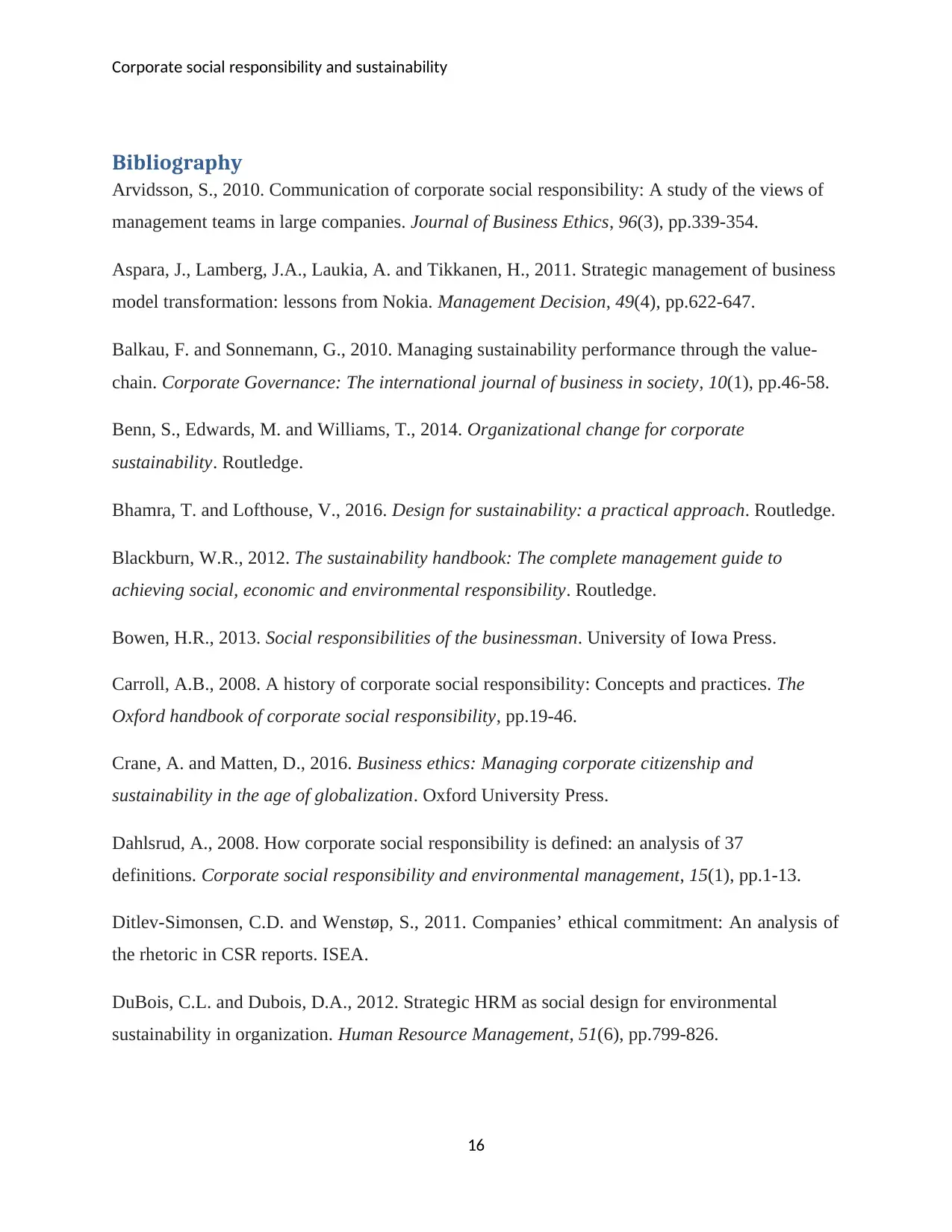
Corporate social responsibility and sustainability
Bibliography
Arvidsson, S., 2010. Communication of corporate social responsibility: A study of the views of
management teams in large companies. Journal of Business Ethics, 96(3), pp.339-354.
Aspara, J., Lamberg, J.A., Laukia, A. and Tikkanen, H., 2011. Strategic management of business
model transformation: lessons from Nokia. Management Decision, 49(4), pp.622-647.
Balkau, F. and Sonnemann, G., 2010. Managing sustainability performance through the value-
chain. Corporate Governance: The international journal of business in society, 10(1), pp.46-58.
Benn, S., Edwards, M. and Williams, T., 2014. Organizational change for corporate
sustainability. Routledge.
Bhamra, T. and Lofthouse, V., 2016. Design for sustainability: a practical approach. Routledge.
Blackburn, W.R., 2012. The sustainability handbook: The complete management guide to
achieving social, economic and environmental responsibility. Routledge.
Bowen, H.R., 2013. Social responsibilities of the businessman. University of Iowa Press.
Carroll, A.B., 2008. A history of corporate social responsibility: Concepts and practices. The
Oxford handbook of corporate social responsibility, pp.19-46.
Crane, A. and Matten, D., 2016. Business ethics: Managing corporate citizenship and
sustainability in the age of globalization. Oxford University Press.
Dahlsrud, A., 2008. How corporate social responsibility is defined: an analysis of 37
definitions. Corporate social responsibility and environmental management, 15(1), pp.1-13.
Ditlev-Simonsen, C.D. and Wenstøp, S., 2011. Companies’ ethical commitment: An analysis of
the rhetoric in CSR reports. ISEA.
DuBois, C.L. and Dubois, D.A., 2012. Strategic HRM as social design for environmental
sustainability in organization. Human Resource Management, 51(6), pp.799-826.
16
Bibliography
Arvidsson, S., 2010. Communication of corporate social responsibility: A study of the views of
management teams in large companies. Journal of Business Ethics, 96(3), pp.339-354.
Aspara, J., Lamberg, J.A., Laukia, A. and Tikkanen, H., 2011. Strategic management of business
model transformation: lessons from Nokia. Management Decision, 49(4), pp.622-647.
Balkau, F. and Sonnemann, G., 2010. Managing sustainability performance through the value-
chain. Corporate Governance: The international journal of business in society, 10(1), pp.46-58.
Benn, S., Edwards, M. and Williams, T., 2014. Organizational change for corporate
sustainability. Routledge.
Bhamra, T. and Lofthouse, V., 2016. Design for sustainability: a practical approach. Routledge.
Blackburn, W.R., 2012. The sustainability handbook: The complete management guide to
achieving social, economic and environmental responsibility. Routledge.
Bowen, H.R., 2013. Social responsibilities of the businessman. University of Iowa Press.
Carroll, A.B., 2008. A history of corporate social responsibility: Concepts and practices. The
Oxford handbook of corporate social responsibility, pp.19-46.
Crane, A. and Matten, D., 2016. Business ethics: Managing corporate citizenship and
sustainability in the age of globalization. Oxford University Press.
Dahlsrud, A., 2008. How corporate social responsibility is defined: an analysis of 37
definitions. Corporate social responsibility and environmental management, 15(1), pp.1-13.
Ditlev-Simonsen, C.D. and Wenstøp, S., 2011. Companies’ ethical commitment: An analysis of
the rhetoric in CSR reports. ISEA.
DuBois, C.L. and Dubois, D.A., 2012. Strategic HRM as social design for environmental
sustainability in organization. Human Resource Management, 51(6), pp.799-826.
16
Secure Best Marks with AI Grader
Need help grading? Try our AI Grader for instant feedback on your assignments.
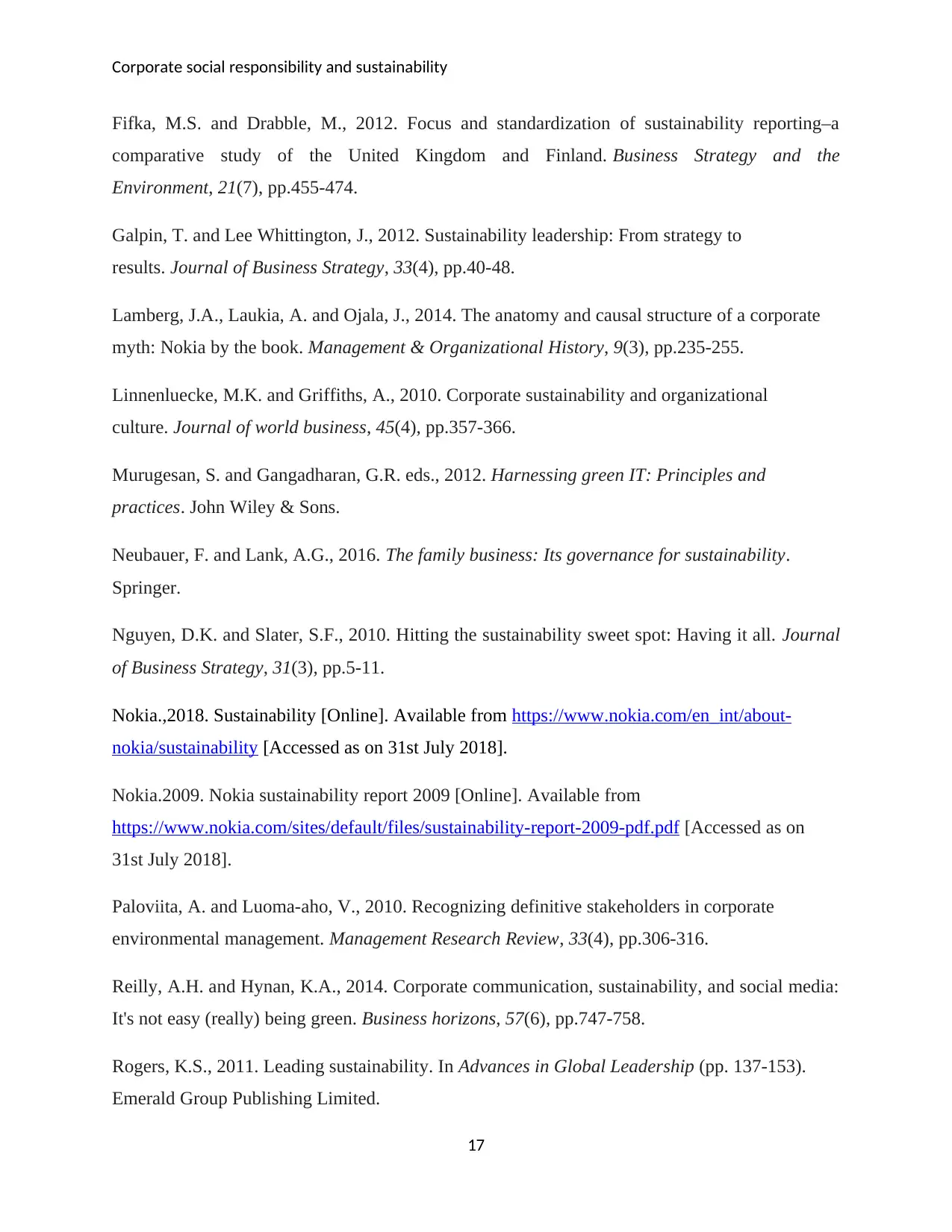
Corporate social responsibility and sustainability
Fifka, M.S. and Drabble, M., 2012. Focus and standardization of sustainability reporting–a
comparative study of the United Kingdom and Finland. Business Strategy and the
Environment, 21(7), pp.455-474.
Galpin, T. and Lee Whittington, J., 2012. Sustainability leadership: From strategy to
results. Journal of Business Strategy, 33(4), pp.40-48.
Lamberg, J.A., Laukia, A. and Ojala, J., 2014. The anatomy and causal structure of a corporate
myth: Nokia by the book. Management & Organizational History, 9(3), pp.235-255.
Linnenluecke, M.K. and Griffiths, A., 2010. Corporate sustainability and organizational
culture. Journal of world business, 45(4), pp.357-366.
Murugesan, S. and Gangadharan, G.R. eds., 2012. Harnessing green IT: Principles and
practices. John Wiley & Sons.
Neubauer, F. and Lank, A.G., 2016. The family business: Its governance for sustainability.
Springer.
Nguyen, D.K. and Slater, S.F., 2010. Hitting the sustainability sweet spot: Having it all. Journal
of Business Strategy, 31(3), pp.5-11.
Nokia.,2018. Sustainability [Online]. Available from https://www.nokia.com/en_int/about-
nokia/sustainability [Accessed as on 31st July 2018].
Nokia.2009. Nokia sustainability report 2009 [Online]. Available from
https://www.nokia.com/sites/default/files/sustainability-report-2009-pdf.pdf [Accessed as on
31st July 2018].
Paloviita, A. and Luoma-aho, V., 2010. Recognizing definitive stakeholders in corporate
environmental management. Management Research Review, 33(4), pp.306-316.
Reilly, A.H. and Hynan, K.A., 2014. Corporate communication, sustainability, and social media:
It's not easy (really) being green. Business horizons, 57(6), pp.747-758.
Rogers, K.S., 2011. Leading sustainability. In Advances in Global Leadership (pp. 137-153).
Emerald Group Publishing Limited.
17
Fifka, M.S. and Drabble, M., 2012. Focus and standardization of sustainability reporting–a
comparative study of the United Kingdom and Finland. Business Strategy and the
Environment, 21(7), pp.455-474.
Galpin, T. and Lee Whittington, J., 2012. Sustainability leadership: From strategy to
results. Journal of Business Strategy, 33(4), pp.40-48.
Lamberg, J.A., Laukia, A. and Ojala, J., 2014. The anatomy and causal structure of a corporate
myth: Nokia by the book. Management & Organizational History, 9(3), pp.235-255.
Linnenluecke, M.K. and Griffiths, A., 2010. Corporate sustainability and organizational
culture. Journal of world business, 45(4), pp.357-366.
Murugesan, S. and Gangadharan, G.R. eds., 2012. Harnessing green IT: Principles and
practices. John Wiley & Sons.
Neubauer, F. and Lank, A.G., 2016. The family business: Its governance for sustainability.
Springer.
Nguyen, D.K. and Slater, S.F., 2010. Hitting the sustainability sweet spot: Having it all. Journal
of Business Strategy, 31(3), pp.5-11.
Nokia.,2018. Sustainability [Online]. Available from https://www.nokia.com/en_int/about-
nokia/sustainability [Accessed as on 31st July 2018].
Nokia.2009. Nokia sustainability report 2009 [Online]. Available from
https://www.nokia.com/sites/default/files/sustainability-report-2009-pdf.pdf [Accessed as on
31st July 2018].
Paloviita, A. and Luoma-aho, V., 2010. Recognizing definitive stakeholders in corporate
environmental management. Management Research Review, 33(4), pp.306-316.
Reilly, A.H. and Hynan, K.A., 2014. Corporate communication, sustainability, and social media:
It's not easy (really) being green. Business horizons, 57(6), pp.747-758.
Rogers, K.S., 2011. Leading sustainability. In Advances in Global Leadership (pp. 137-153).
Emerald Group Publishing Limited.
17
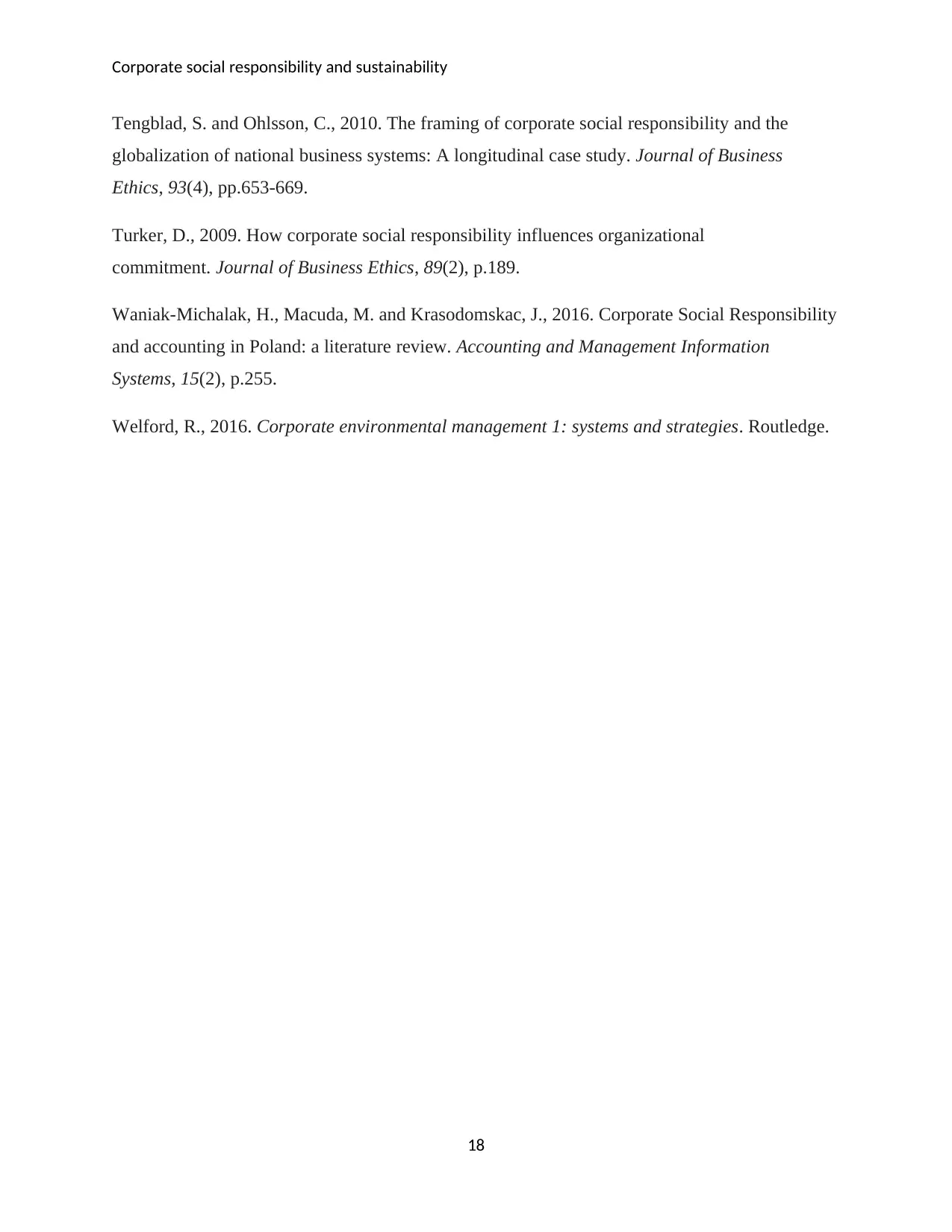
Corporate social responsibility and sustainability
Tengblad, S. and Ohlsson, C., 2010. The framing of corporate social responsibility and the
globalization of national business systems: A longitudinal case study. Journal of Business
Ethics, 93(4), pp.653-669.
Turker, D., 2009. How corporate social responsibility influences organizational
commitment. Journal of Business Ethics, 89(2), p.189.
Waniak-Michalak, H., Macuda, M. and Krasodomskac, J., 2016. Corporate Social Responsibility
and accounting in Poland: a literature review. Accounting and Management Information
Systems, 15(2), p.255.
Welford, R., 2016. Corporate environmental management 1: systems and strategies. Routledge.
18
Tengblad, S. and Ohlsson, C., 2010. The framing of corporate social responsibility and the
globalization of national business systems: A longitudinal case study. Journal of Business
Ethics, 93(4), pp.653-669.
Turker, D., 2009. How corporate social responsibility influences organizational
commitment. Journal of Business Ethics, 89(2), p.189.
Waniak-Michalak, H., Macuda, M. and Krasodomskac, J., 2016. Corporate Social Responsibility
and accounting in Poland: a literature review. Accounting and Management Information
Systems, 15(2), p.255.
Welford, R., 2016. Corporate environmental management 1: systems and strategies. Routledge.
18
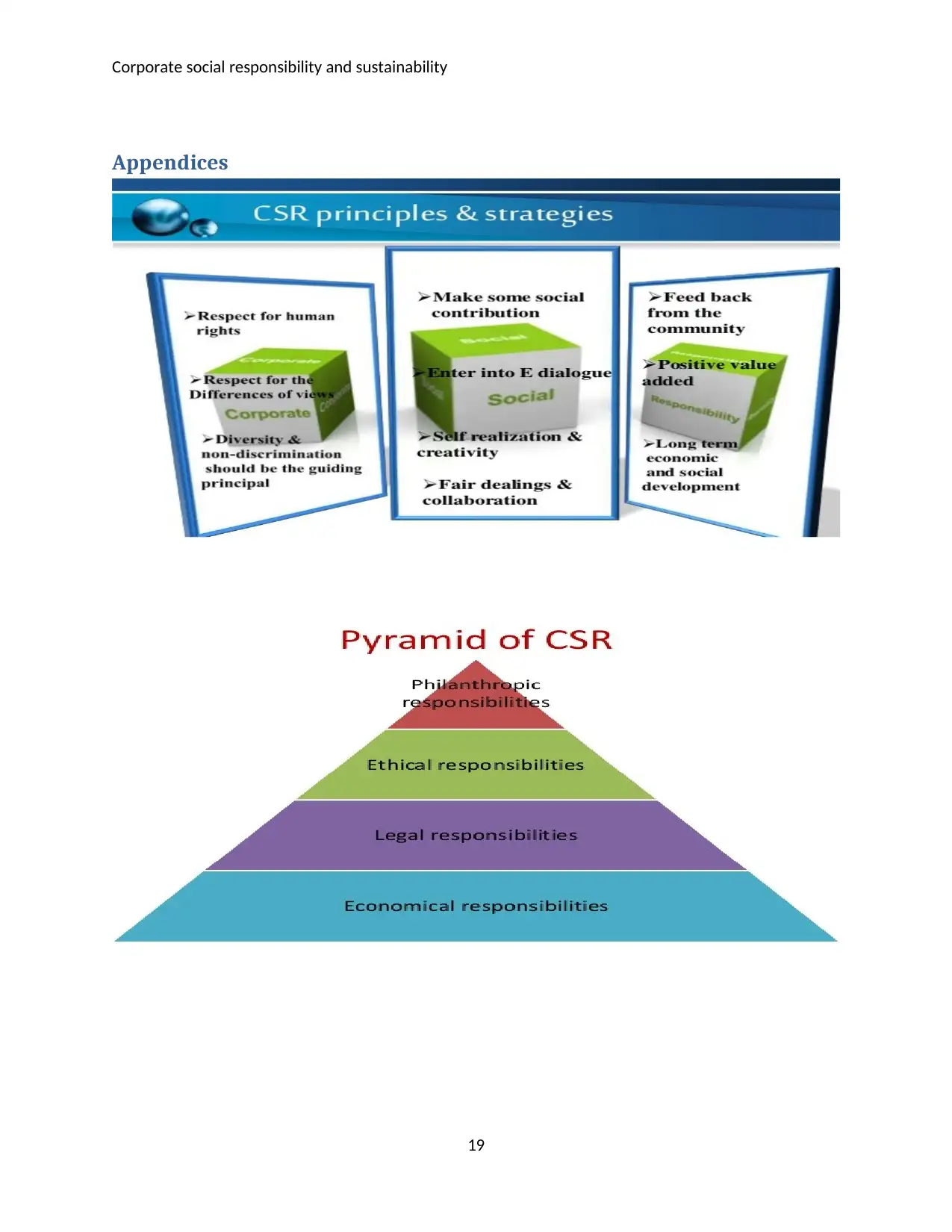
Corporate social responsibility and sustainability
Appendices
19
Appendices
19
Paraphrase This Document
Need a fresh take? Get an instant paraphrase of this document with our AI Paraphraser
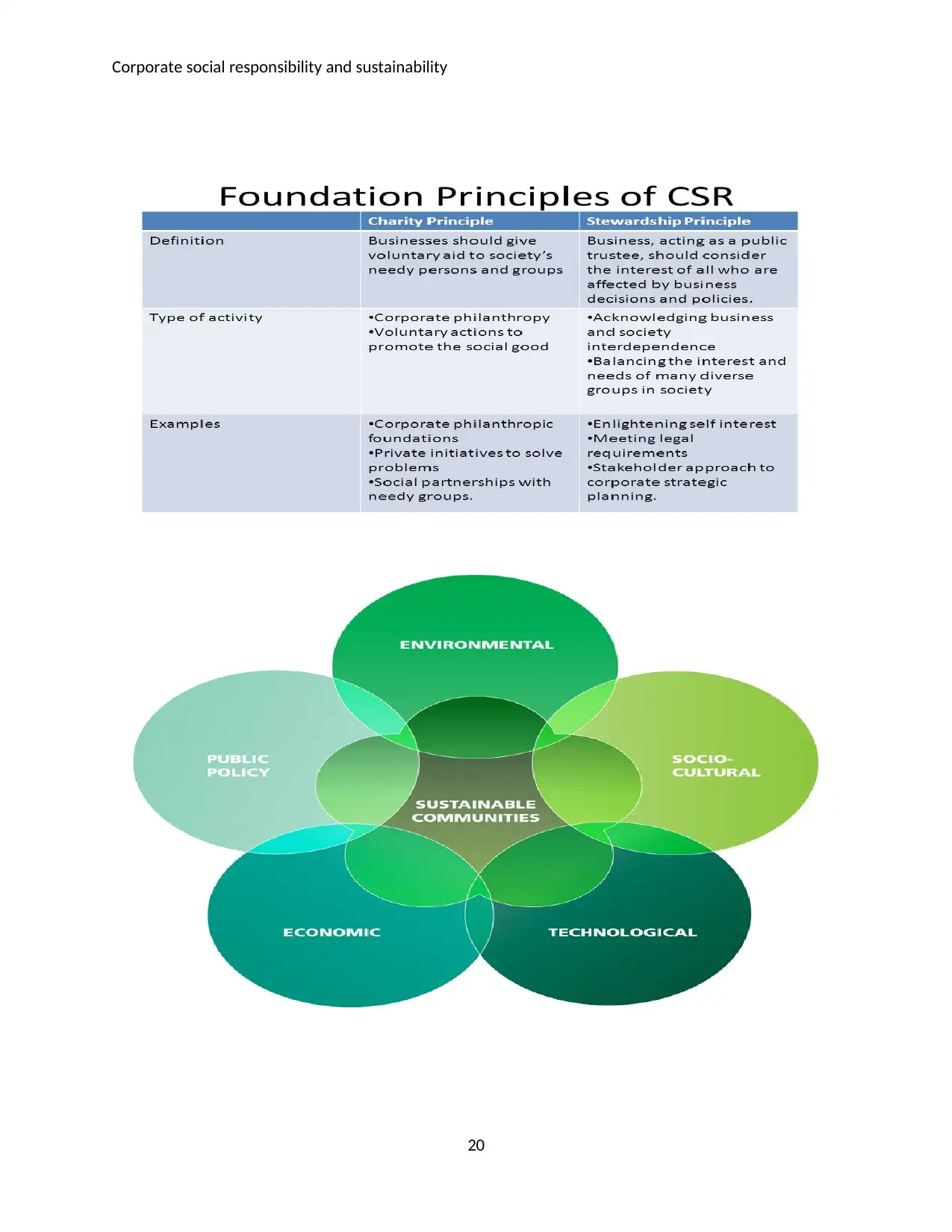
Corporate social responsibility and sustainability
20
20
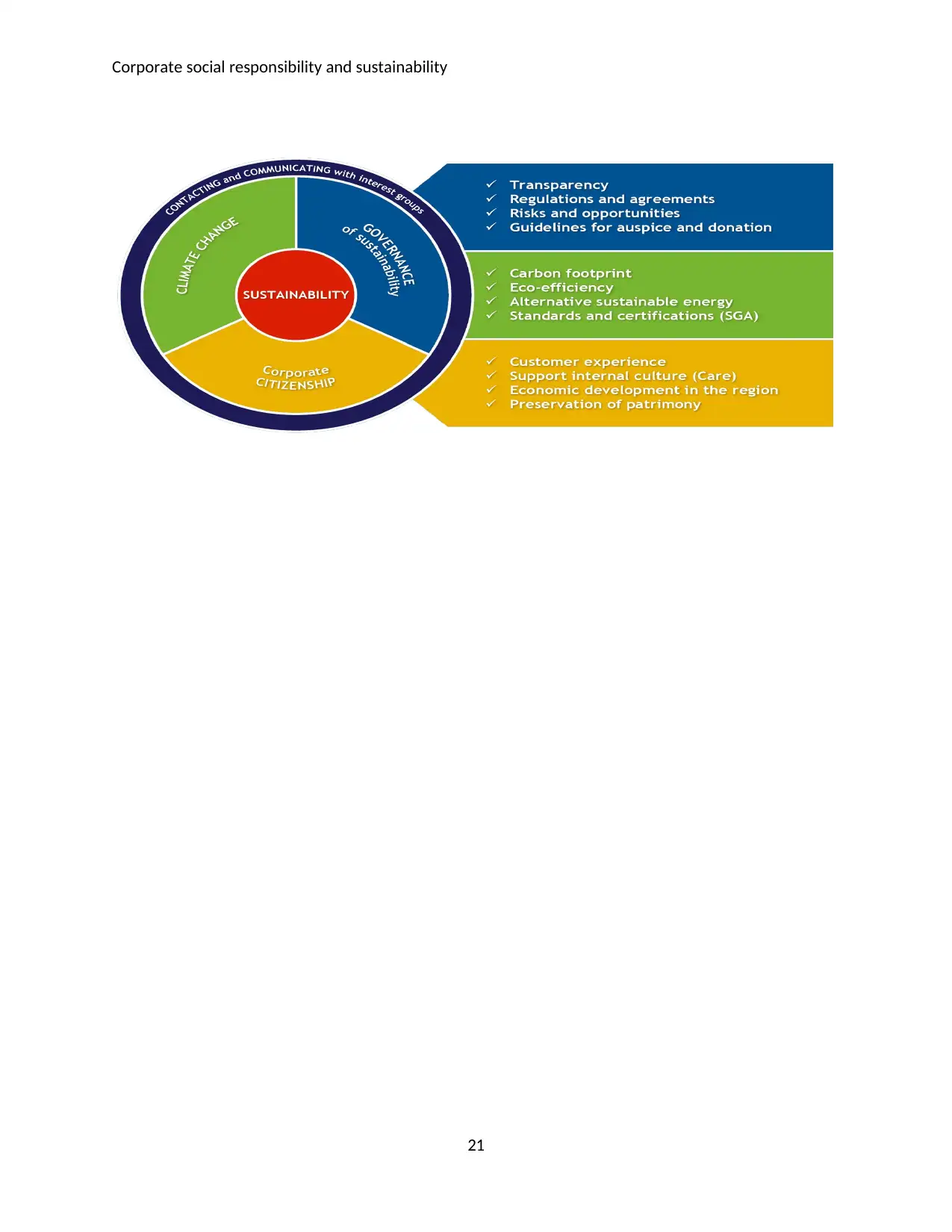
Corporate social responsibility and sustainability
21
21
1 out of 21
Related Documents
Your All-in-One AI-Powered Toolkit for Academic Success.
+13062052269
info@desklib.com
Available 24*7 on WhatsApp / Email
![[object Object]](/_next/static/media/star-bottom.7253800d.svg)
Unlock your academic potential
© 2024 | Zucol Services PVT LTD | All rights reserved.




